Attached files
DENMARK BANCSHARES, INC.
EXHIBIT (13.1)
Annual Report

5
TABLE OF CONTENTS
|
President's Letter |
1 |
|
Selected Financial Data |
5 |
|
Report of Independent Registered Public Accounting Firm |
7 |
|
Report on Internal Control Over Financial Reporting |
8 |
|
Consolidated Financial Statements |
9 |
|
Notes to Consolidated Financial Statements |
13 |
|
Management's Discussion and Analysis |
30 |
|
Directors and Executive Officers |
52 |
|
Quarterly Financial Information |
53 |
|
Stock Performance |
54 |
|
Denmark Bancshares, Inc. ("DBI"), headquartered in Denmark, Wisconsin, is a diversified one-bank holding company. Denmark State Bank ("DSB"), DBI's subsidiary bank, offers six full service banking offices located in the Villages of Denmark, Bellevue, Maribel, Reedsville, Whitelaw and Wrightstown, serving primarily Brown, Kewaunee, Manitowoc and Outagamie Counties. DBI also extends farm credit through its subsidiary Denmark Agricultural Credit Corporation ("DACC"). |
6
REPORT OF INDEPENDENT REGISTERED PUBLIC ACCOUNTING FIRM

Report of Independent Registered Public Accounting Firm
Board of Directors and Stockholders
Denmark Bancshares, Inc.
Denmark, Wisconsin
We have audited the accompanying consolidated balance sheets of Denmark Bancshares, Inc. and Subsidiaries as of December 31, 2009 and 2008, and the related consolidated statements of income, changes in stockholders' equity, and cash flows for each of the years in the three-year period ended December 31, 2009. These financial statements are the responsibility of the Company's management. Our responsibility is to express an opinion on these financial statements based on our audits.
We conducted our audits in accordance with standards of the Public Company Accounting Oversight Board (United States). Those standards require that we plan and perform the audit to obtain reasonable assurance about whether the financial statements are free of material misstatements. The Company is not required to have, nor were we engaged to perform, an audit of its internal control over financial reporting. Our audit included considerations of internal control over financial reporting as a basis for designing audit procedures that are appropriate in the circumstances, but not for the purpose of expressing an opinion on the effectiveness of the Company's internal control over financial reporting. Accordingly, we express no such opinion. An audit includes examining, on a test basis, evidence supporting the amounts and disclosures in the financial statements. An audit also includes assessing the accounting principles used and significant estimates made by management, as well as evaluating the overall financial statement presentation. We believe that our audits provide a reasonable basis for our opinion.
In our opinion, the consolidated financial statements referred to above present fairly, in all material respects, the financial position of Denmark Bancshares, Inc. and Subsidiaries at December 31, 2009 and 2008, and the results of their operations and their cash flows for each of the years in the three-year period ended December 31, 2009, in conformity with accounting principles generally accepted in the United States.
Wipfli LLP
February 23, 2010
Green Bay, Wisconsin
7
MANAGEMENT'S REPORT ON INTERNAL CONTROL OVER FINANCIAL REPORTING
The management of Denmark Bancshares, Inc. ("DBI") is responsible for establishing and maintaining adequate internal control over financial reporting. DBI's internal control system was designed to provide reasonable assurance as to the reliability of financial reporting and the preparation and presentation of the consolidated financial statements for external purposes in accordance with generally accepted accounting principles.
All internal control systems, no matter how well designed, have inherent limitations. Therefore, even those systems determined to be effective can provide only reasonable assurance with respect to financial statement preparation and presentation.
DBI's management conducted an assessment, including testing, of the effectiveness of its internal control over financial reporting as of December 31, 2009. In making this assessment, DBI used the criteria set forth by the Committee of Sponsoring Organizations of the Treadway Commission (COSO) in Internal Control - Integrated Framework. Based on this assessment, DBI's management believes that, as of December 31, 2009, DBI's internal control over financial reporting is effective based on those criteria.
This Annual Report on Form 10-K does not include an attestation report of DBI's registered accounting firm regarding internal control over financial reporting.
Management's report was not subject to attestation by the Company's registered public accounting firm pursuant to temporary rules of the Securities and Exchange Commission that permit the Company to provide only management's report in this Annual Report.
![]()
![]()
John P. Olsen Dennis J. Heim
CEO and President CFO and Vice President
8
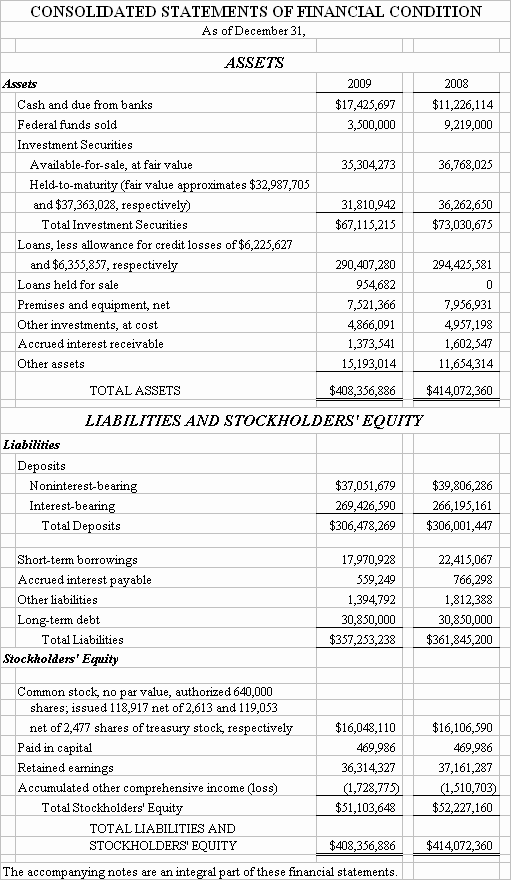
9
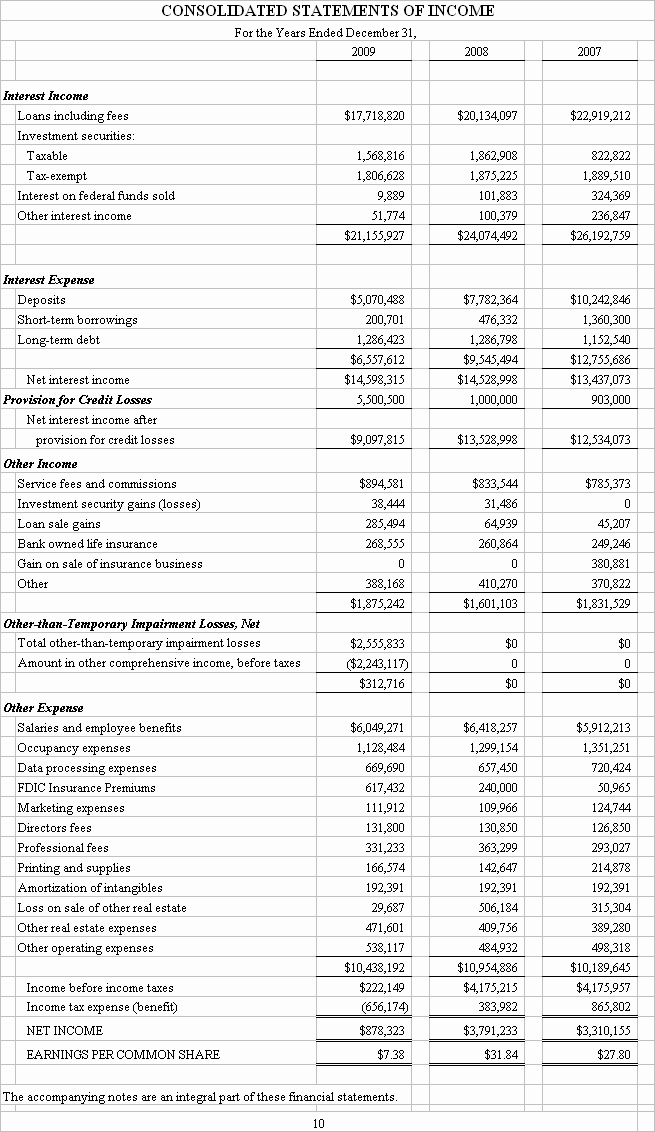
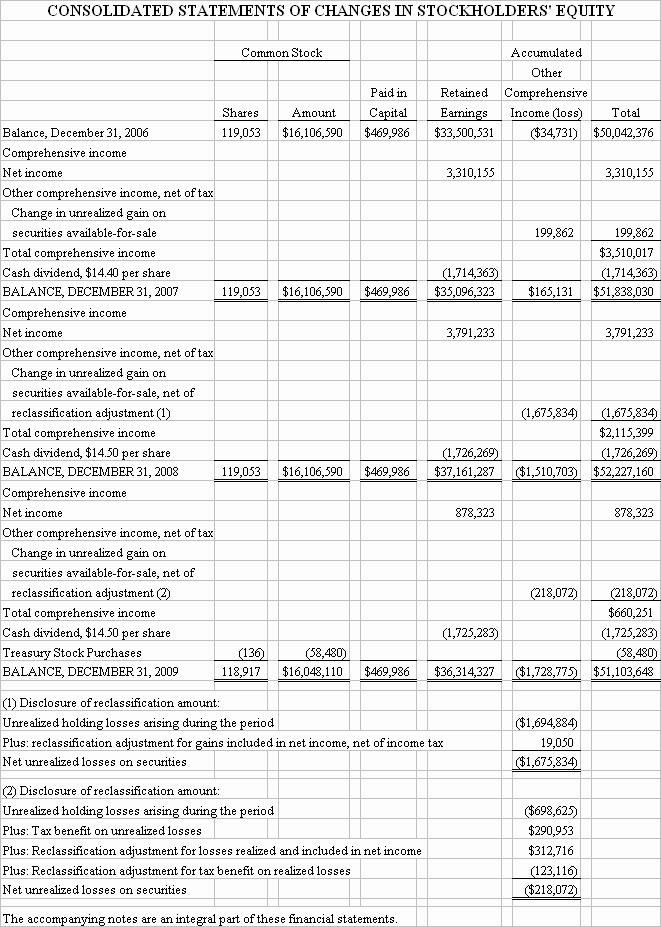
11
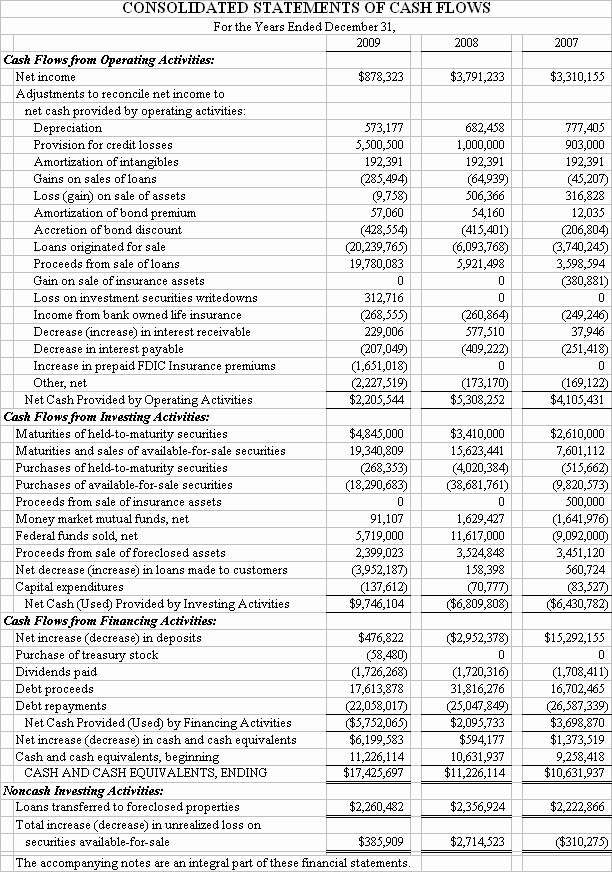
12
NOTES TO CONSOLIDATED FINANCIAL STATEMENTS
NOTE 1 - SUMMARY OF SIGNIFICANT ACCOUNTING POLICIES
Nature of Organization
Denmark Bancshares, Inc. ("DBI") is a bank holding company as defined in the Bank Holding Company Act. As such, it exercises control over Denmark State Bank ("DSB"), Denmark Ag Credit Corporation ("DACC") and McDonald-Zeamer Insurance Agency, Inc. ("McDonald"). A majority of DBI's assets are held by DSB. On January 2, 2007, McDonald sold its insurance book of business and agreed to exit the insurance business for a period of three years. DBI Properties, Inc. was formed in February 2009 for the purpose of holding certain foreclosed properties.
DSB, a wholly owned subsidiary of DBI, operates under a state bank charter, and provides full banking services to its customers. Denmark Investments Inc. ("DII") is a wholly owned subsidiary of Denmark State Bank. DBI and its subsidiaries make agribusiness, commercial and residential loans to customers throughout the state, but primarily in eastern Wisconsin. DBI and its subsidiaries have a diversified loan portfolio, however, a substantial portion of their debtors' ability to honor their contract is dependent upon the agribusiness economic sector. The main loan and deposit accounts are fully disclosed in Notes 4 and 7. The significant risks associated with financial institutions include interest rate risk, credit risk, liquidity risk and concentration risk.
Basis of Consolidation
The consolidated financial statements include the accounts of Denmark Bancshares, Inc. and its subsidiaries. All intercompany balances and transactions have been eliminated in consolidation.
Use of Estimates
The preparation of financial statements in conformity with generally accepted accounting principles requires management to make estimates and assumptions that affect the reported amounts of assets and liabilities and disclosure of contingent assets and liabilities at the date of the financial statements and the reported amounts of revenues and expenses during the reporting period. Actual results could differ from those estimates. Significant estimates in the financial statements include allowance for credit losses and accounting for the impairment of loans, which are discussed specifically in the following sections of this footnote.
Cash Flows
For purposes of reporting cash flows, cash and cash equivalents include cash on hand and amounts due from banks. Cash flows from demand deposits, NOW accounts, savings accounts, federal funds purchased and sold, cash receipts and payments of loans and time deposits are reported net. For purposes of cash flow reporting, income taxes paid were $266,992, $890,818 and $867,610 and interest paid was $6,776,072, $9,963,669 and $13,015,713 for the years ended December 31, 2009, 2008 and 2007, respectively.
Investment Securities
Investment securities are designated as available-for-sale or held-to-maturity when purchased and remain in that classification until they are sold or mature. Debt and equity securities classified as available-for-sale are stated at estimated fair value, with unrealized gains and losses, net of any applicable deferred income taxes, reported as a separate component of stockholders' equity. Debt securities classified as held-to-maturity are stated at cost adjusted for amortization of premiums and accretion of discounts, which are recognized as adjustments to interest income. Realized gains or losses on dispositions are recorded in other operating income on the trade date, based on the net proceeds and the adjusted carrying amount of the securities sold using the specific identification method.
Declines in fair value of securities that are deemed to be other-than-temporary, if applicable, are reflected in earnings as realized losses. In estimating other-than-temporary impairment losses, management considers the length of time and the extent to which fair value has been less than cost, the financial condition and near-term prospects of the issuer, and the intent and ability of the Company to retain its investment in the issuer for a period of time sufficient to allow for any anticipated recovery in fair value.
Loans
Loans are reported at the principal amount outstanding, net of the allowance for credit losses. Interest on loans is calculated and accrued by using the simple interest method on the daily balance of the principal amount outstanding. Loan-origination fees are credited to income when received and the related loan-origination costs are expensed as incurred. Capitalization of the fees net of the related costs would not have a material effect on the consolidated financial statements.
Loans on which the accrual of interest has been discontinued are designated as nonaccrual loans. Accrual of interest on loans is discontinued either when reasonable doubt exists as to the full, timely collection of interest or principal or when a loan becomes contractually past due by ninety days or more with respect to interest or principal. When a loan is placed on nonaccrual, all interest previously accrued but not collected is reversed against current period interest income. Income on such loans is then recognized only to the extent that cash is received and where the future collection of principal is probable. Interest accruals are resumed on such loans only when they are brought fully current with respect to interest and principal and when, in the judgment of the management, the loans are estimated to be fully collectible as to both principal and interest.
13
NOTES TO CONSOLIDATED FINANCIAL STATEMENTS
A loan is impaired when, based on current information and events, it is probable that not all amounts due will be collected according to the contractual terms of the loan agreement. Impaired loans are measured at the estimated fair value of the collateral. If the estimated fair value of the impaired loan is less than the recorded investment in the loan, an impairment is recognized by creating a valuation allowance. Interest income is recognized in the same manner described above for nonaccrual loans.
Allowance for Credit Losses
The allowance for credit losses is established through a provision for credit losses charged to expense as losses are estimated to have occurred. Loan losses are charged against the allowance for credit losses when management believes that the collectibility of the principal is unlikely. Subsequent recoveries, if any, are credited to the allowance.
Management regularly evaluates the allowance for loan losses using the Company's past loan loss experience, known and inherent risks in the portfolio, composition of the portfolio, adverse situations that may affect the borrower's ability to repay, estimated value of any underlying collateral, current economic conditions and other relevant factors. This evaluation is inherently subjective since it requires material estimates that may be susceptible to significant change.
The allowance for loan losses consists of specific, general and unallocated components. The specific component relates to loans that are classified as doubtful, substandard, or special mention and includes allowances estimated for impaired loans. The general component covers nonclassified loans and is based on historical loss experience adjusted for qualitative factors. An unallocated component is maintained to cover uncertainties that could affect management's estimate of probable losses and reflects the margin of imprecision inherent in the underlying assumptions used in the methodologies for estimating specific and general losses in the portfolio.
The allowance for loan losses includes specific allowances related to loans that have been judged to be impaired under current accounting standards. A loan is impaired when, based on current information, it is probable that the Company will not collect all amounts due in accordance with the contractual terms of the loan agreement. Management determines whether a loan is impaired on a case-by-case basis, taking into consideration the payment status, collateral value, length and reason of any payment delays, the borrower's prior payment record, and any other relevant factors. Large groups of smaller balance homogeneous loans, such as residential mortgage and consumer loans, are collectively evaluated in the allowance for loan losses analysis and are not subject to impairment analysis unless such loans have been subject to a restructuring agreement. Specific allowances for impaired loans are based on discounted cash flows of expected future payments using the loan's initial effective interest rate or the fair value of the collateral if the loan is collateral dependent.
In addition, various regulatory agencies periodically review the allowance for loan losses. These agencies may require additions to the allowance for loan losses based on their judgments of collectability.
Loans Held For Sale
Loans originated and intended for sale in the secondary market are carried at lower of cost or estimated fair value in the aggregate. Net unrealized losses, if any, are recognized through a valuation allowance by charges to income.
Other Real Estate Owned
Other real estate owned represents real estate of which DBI has taken control in partial or total satisfaction of loans. Other real estate owned is carried at fair value, less estimated costs to sell. Losses at the time property is classified as other real estate owned are charged to the allowance for credit losses. Subsequent gains and losses, as well as operating income or expense related to other real estate owned, are charged to expense. Other real estate owned, which is included in other assets, totaled $1,700,280 and $867,507 at December 31, 2009 and 2008, respectively.
Other Investments
Other investments are carried at cost and consist primarily of Federal Home Loan Bank (FHLB) stock, money market funds held by the investment subsidiary and AgriBank stock. Other investments are evaluated for impairment on an annual basis. As a member of the FHLB, DSB is required to hold stock in the FHLB based on the anticipated amount of FHLB borrowings to be advanced. This stock is recorded at cost, which approximates fair value. Transfer of the stock is substantially restricted.
Premises and Equipment
Premises and equipment owned are stated at cost less accumulated depreciation which is computed principally on the straight-line method over the estimated useful lives of the assets. The estimated useful lives of the assets are forty years for buildings, fifteen years for leasehold improvements and three to seven years for furniture and equipment.
Intangible Assets
Other intangibles, which include primarily core deposit intangibles, are amortized on a straight-line basis generally over a period of up to 15 years. Annually management reviews the intangible assets for impairment. Other intangibles are included in Other Assets.
14
NOTES TO CONSOLIDATED FINANCIAL STATEMENTS
Income Taxes
Deferred income tax assets and liabilities are determined using the liability method. Under this method the net deferred income taxes are provided for timing differences between book and tax bases of assets and liabilities in the consolidated financial statements and those reported for income tax purposes. A liability may also be recognized for unrecognized tax benefits from uncertain tax positions. Unrecognized tax benefits represent the differences between a tax position taken or expected to be taken in a tax return and the benefit recognized and measured in the financial statements. Interest and penalties related to unrecognized tax benefits are classified as income taxes.
Treasury Stock
Treasury stock consists of 2,613 shares at a cost of $2,125,866 as of December 31, 2009 and 2,477 shares at a cost of $2,067,386 as of December 31, 2008 and is netted against common stock on the consolidated statement of financial condition.
Earnings per Common Share
Earnings per common share are computed based on the weighted average number of shares of common stock outstanding during each year. DBI does not have any stock based compensation plans, therefore basic and diluted earnings per share are presented as one number. The number of shares used in computing basic earnings per share is 119,002, 119,053 and 119,053 for the years ended December 31, 2009, 2008 and 2007, respectively.
Reclassifications
Certain amounts in the prior year financial statements have been reclassified for comparative purposes to conform with the presentation in the current year.
New Accounting Pronouncements
On July 1, 2009, The FASB Accounting Standards Codification and the Hierarchy of Generally Accepted Accounting Principles became Financial Accounting Standards Board's (FASB's) officially recognized source of authoritative U.S. generally accepted accounting principles (GAAP) and established a new hierarchy of GAAP sources for non-governmental entities. It supersedes all accounting standards in U.S. GAAP, aside from those issued by the Securities and Exchange Commission. This standard is not expected to have a significant effect on DBI's financial statements but will affect the way GAAP standards are referred to in the financial statements and accounting policies.
In December 2007, the FASB issues Statement of Accounting Standards (SFAS) No. 160, "Non-controlling Interests in Consolidated Financial Statements," which was subsequently incorporated into FASB Accounting Standards Codification (ASC) Topic 810, "Consolidation." New authoritative accounting guidance under this ASC topic amended prior guidance to establish accounting and reporting standards for a non-controlling interest in a subsidiary and for the deconsolidation of a subsidiary. A non-controlling interest in a subsidiary, which is sometimes referred to as minority interest, under this topic is an ownership interest in the consolidated entity that should be reported as a component of equity in the consolidated financial statements, but separate from the parent's equity. It also requires consolidated net income attributable to the parent and to the minority interest to be clearly presented on the face of the consolidated statement of income. This new authoritative accounting guidance become effective on January 1, 2009 and did not have a significant impact on DBI's financial statements.
In December 2007, the FASB issues SFAS No. 141R, "Business Combinations," which was subsequently incorporated into FASB ASC Topic 805, "Business Combinations." This topic establishes principles and requirements for the acquirer in a business combination to recognize and measure identifiable assets acquired and liabilities assumed; to recognize and measure goodwill acquired or gain from a bargain purchase; and to determine what information to disclose in the financial statements. Topic 805 is effective for business combinations for which the acquisition date determined in accordance with this guidance is on or after the beginning of the first annual reporting period beginning on or after December 15, 2008. The new authoritative accounting guidance also addresses application issues on initial recognition and measurement, subsequent measurement and accounting, and disclosures of assets and liabilities arising from contingencies in a business combination. Adoption of this ASC topic did not have a significant effect on DBI's financial statements.
In April 2009, the FASB issues FASB Staff Position (FSP) Financial Account Standard (FAS) 107-1, "Interim Disclosures about Fair Value Instruments," which was subsequently incorporated into FASB ASC Topic 825, "Financial Instruments." New authoritative accounting guidance under Topic 825 requires an entity to provide disclosures about the fair value of financial instruments in interim financial information and amends prior guidance to require those disclosures in summarized financial information at interim reporting periods. The early adoption of these disclosure requirements had no significant effect on DBI's financial statements.
15
In April 2009, the FASB issues FSP FAS 115-2 and FAS 124-2, "Recognition and Presentation of Other-Than-Temporary Impairments," which was subsequently incorporated into FASB ASC Topic 320, "Investments - Debt and Equity Securities." This ASC amends the other-than-temporary impairment guidance in U.S. GAAP for debt securities to make the guidance more operational and to improve the presentation and disclosure of other-than-temporary impairments on debt and equity securities in the financial statements. Under Topic 320, if the determination is made that there is other-than-temporary impairment ("OTTI") and the determination is made that a credit loss exists but the entity does not intend to sell the debt security and it is not more likely than not that the entity will be required to sell the debt security before the anticipated recovery of its remaining amortized cost basis, the presentation and amount of the other-than-temporary impairment recognized in the statement of earnings is changed. Only the portion related to the credit loss is recognized in the statement of earnings and the impairment related to all other factors is recognized in other comprehensive income. DBI adopted this authoritative accounting guidance during the first quarter of 2009 and this early adoption had a significant effect on the financial statements. If early adoption had not been elected, the unrealized losses on two securities determined to have OTTI would have been recognized entirely through the income statement. Refer to Note 3 - Investment Securities above for additional information on the unrealized losses related to the two securities with OTTI.
In April 2009, the FASB issued FSP FAS 157-4, "Determining Fair Value When the Volume and Level of Activity for the Asset or Liability Have Significantly Decreased and Identifying Transactions That Are Not Orderly," which was subsequently incorporated into FASB ASC Topic 820, "Fair Value Measurements and Disclosures." This new authoritative accounting guidance relates to determining fair values when there is no active market or where the price inputs being used represent distressed sales. It reaffirms the objective of fair value measurement - to reflect how much an asset would be sold for in an orderly transaction (as opposed to a distressed or forced transaction) at the date of the financial statements under current market conditions.
Specifically, it reaffirms the need to use judgment to ascertain if a formally active market has become inactive and in determining fair values when markets have become inactive. DBI elected to early adopt the accounting guidance under this topic and this adoption had a significant effect on the financial statements. Evaluation of the market conditions for securities backed by non-traditional loan products was deemed to be inactive and additional cash flow analysis was necessary to determine if there was OTTI related to the securities with this type of collateral. Two securities were deemed to be OTTI and as such, there was an impact on the income statement. Refer to Note 3 - Investment Securities above for additional information on these securities and the impact to the income statement.
On May 28, 2009 the FASB announced the issuance of SFAS 165, "Subsequent Events," which was subsequently incorporated into FASB ASC Topic 855, "Subsequent Events." New guidance within this ASC topic establishes general standards for accounting for and disclosure of events that occur after the balance sheet date but before financial statements are issued or available to be issued. Topic 855 defines the period after the balance sheet date during which a reporting entity's management should evaluate events or transactions that may occur for potential recognition or disclosure in the financial statements, the circumstances under which an entity should recognize events or transactions occurring after the balance sheet date in its financial statements, and the disclosures an entity should make about events or transactions that occurred after the balance sheet date. Financial statements are considered available to be issued when they are complete in a form and format that complies with generally accepted accounting principles (GAAP) and all approvals necessary for issuance have been obtained. The adoption of this guidance did not have a significant effect on DBI's financial statements.
On June 12, 2009 the FASB issued two statements that amended the guidance for off-balance-sheet accounting of financial instruments: SFAS No. 166, "Accounting for Transfers of Financial Assets" and SFAS No. 167, "Amendments to FASB Interpretation No. 46(R)," both of which were subsequently incorporated into FASB ASC Topic 860, "Transfers and Servicing." New authoritative accounting guidance under this topic amends prior guidance and will require entities to provide more information about sales and securitized financial assets and similar transactions, particularly if the seller retains some risk to the assets. The statement eliminates the concept of a qualifying special-purpose entity, changes the requirement for de-recognition of financial assets, and calls upon sellers of the assets to make additional disclosures about them. Additional amendments alter how a company determines when an entity that is insufficiently capitalized or not controlled through voting should be consolidated. A company has to determine whether it should provide consolidated reporting of an entity based upon the entity's purpose and design and the parent company's ability to direct the entity's actions. This new guidance will be effective the first annual reporting period that begins after November 15, 2009, for interim reporting periods within that first annual reporting period and for interim and annual reporting periods thereafter and adoption of this guidance did not have a significant effect on DBI's financial statements.
Management evaluated subsequent events as they relate to the financial statements as of February 23, 2010.
NOTE 2 - RESTRICTIONS ON CASH AND AMOUNTS DUE FROM BANKS
DSB is required to maintain non-interest-bearing deposits on hand or with the Federal Reserve Bank. Required reserves of $932,000 and $1,031,000 as of December 31, 2009 and 2008, respectively, were satisfied by currency and coin holdings. Effective December 5, 2008, accounts at each institution where DBI maintains a correspondent banking relationship are insured in full by the Federal Deposit Insurance Corporation Transaction Guarantee Program until June 30, 2010 upon which time the insurance is expected to revert back to $100,000. In 2007, accounts at each institution were insured by the Federal Deposit Insurance Corporation up to $100,000.
16
NOTES TO CONSOLIDATED FINANCIAL STATEMENTS

Mortgage-backed securities are allocated according to their expected prepayments rather than their contractual maturities. Certain state and local governments' securities are allocated according to their put date. Fair values of securities are estimated based on financial models or prices paid for similar securities. It is possible interest rates could change considerably resulting in a material change in the estimated fair value.
Four available-for-sale securities were sold in 2009 resulting in realized gains of $38,444 and total sales proceeds of $3,289,036. Three available-for-sale agency step-up securities were sold in 2008 for total proceeds of $1,364,369, with gross realized gains of $31,486. There were no securities sold in 2007.
17
NOTES TO CONSOLIDATED FINANCIAL STATEMENTS
At December 31, 2009, seventeen debt securities have unrealized losses with aggregate depreciation of 17.0% from DSB's amortized cost basis. Information pertaining to securities with gross unrealized losses at the end of the last two years, aggregated by investment category and length of time that individual securities have been in a continuous loss position follows:
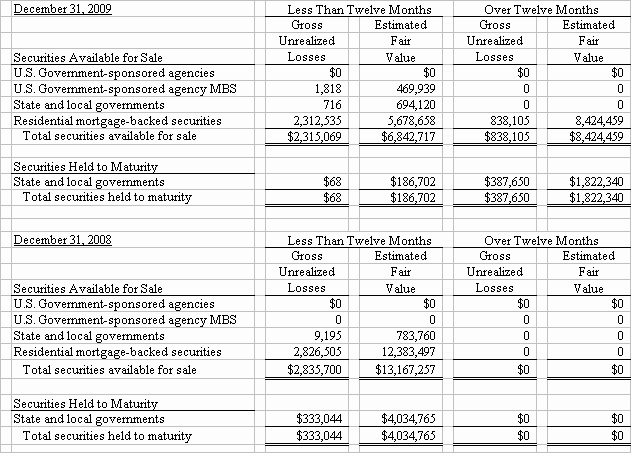
Two corporate-issued residential mortgage-backed securities, previously rated AAA by Standard & Poor's (S&P) and Moody's were downgraded late in the first quarter of 2009 by Moody's to Caa1 and to BB by S&P during the second quarter of 2009. These securities, along with one other corporate-issued residential mortgage-backed security in the portfolio currently rated Aa2 by Moody's, are supported by non-traditional loan types, specifically option adjustable rate mortgages (ARMs), that were originated in 2005 and 2006. The option ARMs include negative amortization features and 40-year amortization schedules. During the second quarter of 2009, a third corporate-issued residential mortgage-backed security secured by traditional loan types was downgraded by Moody's from AAA to B3. All securities with unrealized losses were assessed to determine if the impairment was other-than-temporary. Factors that were evaluated included the mortgage loan types supporting the securities, delinquency and foreclosure rates, credit support, weighted average loan-to-value, and year of origination, among others.
An analysis by a third party was performed on the three residential mortgage-backed securities secured by non-traditional loan types along with the security that was downgraded during the second quarter in order to determine whether they are other-than temporarily impaired (OTTI). The purpose of the third party evaluation was to determine if the present value of the expected cash flows was less than the amortized costs, thereby resulting in credit loss, in accordance with the adoption of authoritative accounting guidance under FASB ASC Topic 320 which is discussed above in Note 1 - New Accounting Pronouncements. The third party determined an estimated fair value for each security based on discounted cash flow analyses. The estimates were based on the following key valuation assumptions - collateral cash flows, prepayment assumptions, default rates, loss severity, liquidation lag, bond waterfall and internal rate of return. Since there is currently no active secondary market for these types of securities due to the non-traditional loan types these valuations are considered Level 3 inputs as defined below in Note 16 - Fair Value Measurement.
18
NOTES TO CONSOLIDATED FINANCIAL STATEMENTS
The two securities that were downgraded during first quarter of 2009 by Moody's were found to have credit losses since a portion of the unrealized losses is due to an expected cash flow shortfall based on an analysis as of March 31, 2009. As such, these securities were determined to be other-than-temporarily impaired. DBI does not intend to sell the investments and it is not more likely than not that DBI will be required to sell the securities before the anticipated recovery of their remaining amortized cost bases, which may be maturity. The total credit loss that was recognized in earnings as of March 31, 2009 for these securities was $312,716. Based on the December 31, 2009 analysis, no additional credit loss was recognized during the fourth quarter. The analysis on the other two securities did not reveal any credit loss nor were the securities found to be OTTI. Unrealized losses on the four securities analyzed by the third party were recognized through accumulated other comprehensive loss on the balance sheet, net of tax in the amount of $1,662,355.

The unrealized losses on the remainder of the residential mortgage-backed securities were due to the distressed and illiquid markets for collateralized mortgage obligations. The securities are investments in senior tranches with adequate credit support from subordinate tranches, are supported by traditional mortgage loans that originated between 2002 and 2005, have low delinquency and foreclosure rates, and reasonable loan-to-value ratios. DBI does not consider these investments to be OTTI at December 31, 2009.
There were no issuers of securities for which a significant concentration of investments (greater than 10 percent of stockholders' equity) was held as of December 31, 2009.
Investment securities with an amortized cost of $2,141,281 and $350,364 and estimated fair value of $2,084,157 and $355,539, at December 31, 2009 and 2008, respectively were pledged to secure public deposits and for other purposes required or permitted by law.
19
NOTES TO CONSOLIDATED FINANCIAL STATEMENTS
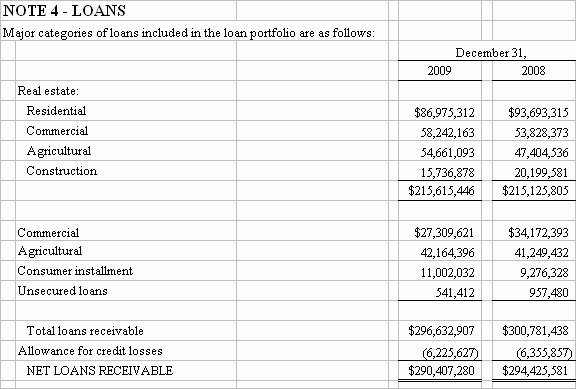
Nonaccrual loans totaled $12,753,127 and $15,518,779 at December 31, 2009 and 2008, respectively. There were no loans past-due ninety days or more and still accruing. The reduction in interest income associated with nonaccrual loans is as follows:
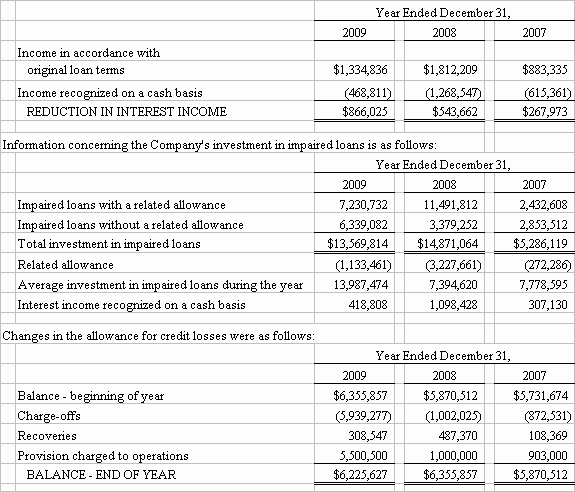
20
NOTES TO CONSOLIDATED FINANCIAL STATEMENTS
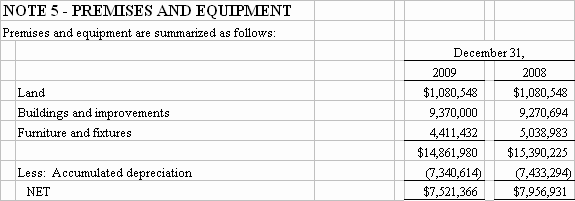
Depreciation expense was $573,177, $682,458 and $777,405 for 2009, 2008 and 2007, respectively.
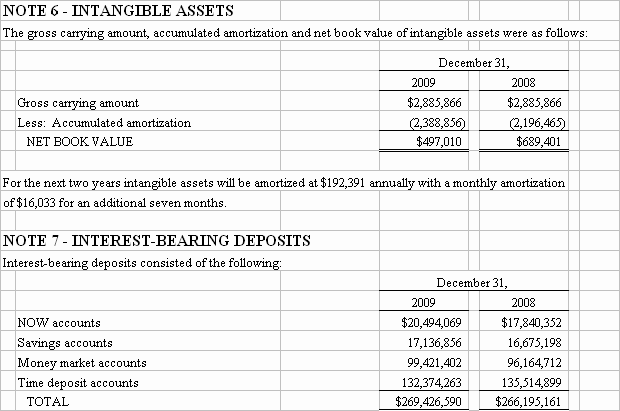
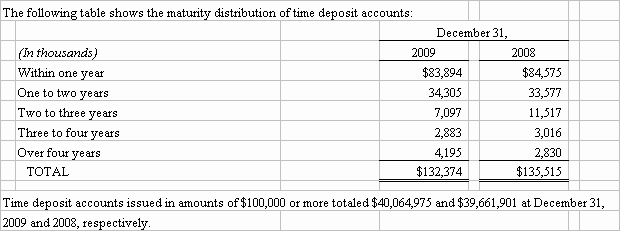
21
NOTES TO CONSOLIDATED FINANCIAL STATEMENTS
NOTE 8- SHORT-TERM BORROWINGS
Short-term borrowings included notes payable of $17,970,928 and $22,415,067 at December 31, 2009 and 2008, respectively. DBI had an advance of $1 million drawn against its $6 million line of credit. The remaining notes payable are secured by Denmark State Bank and Denmark Ag Credit Corporation stock and agricultural loans with a carrying value of $23,990,780 and $23,817,119 as of December 31, 2009 and 2008, respectively. The pledged notes also secure long-term debt. Notes payable have fixed and variable interest rates ranging from 0.81% to 5.00% at December 31, 2009.

The notes payable to Federal Home Loan Bank of Chicago (FHLB) are secured by residential mortgages with a carrying amount of $62,121,876 and $70,904,968 along with $3.6 million of FHLB stock as of December 31, 2009 and 2008, respectively. AgriBank, FCB notes payable are secured by agricultural loans with a carrying value of $23,990,780 and $23,817,119 as of December 31, 2009 and 2008, respectively. The pledged notes also secure short-term borrowings.
As of December 31, 2009, DBI had a total of $53,770,072 of unused lines of credit with banks to be drawn upon as needed.
22
NOTES TO CONSOLIDATED FINANCIAL STATEMENTS
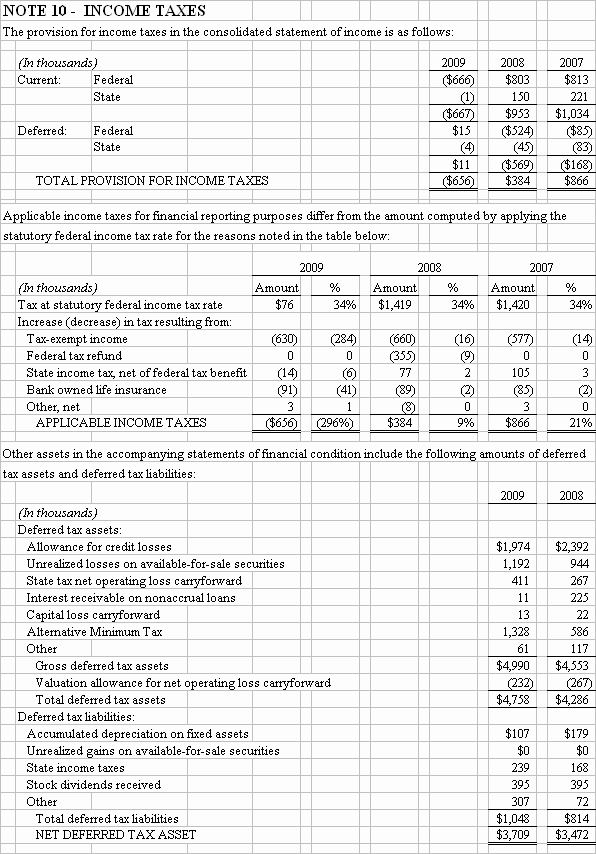
DBI has state net operating loss carryforwards of approximately $3,014,000. Portions of DBI's net operating losses have been expiring since 2000. DBI has an AMT credit carryforward of approximately $1,327,640.
23
NOTES TO CONSOLIDATED FINANCIAL STATEMENTS
NOTE 11 - EMPLOYEE BENEFIT PLAN
DBI has a 401(k) profit sharing and retirement savings plan. The plan essentially covers all employees who have been employed over one-half year, and are at least twenty and one-half years old. Provisions of the 401(k) profit sharing plan provide for the following:
- DBI will contribute 50% of each employee elective contribution up to a maximum DBI contribution of 2%. Employee contributions above 4% do not receive any matching contribution.
- DBI may elect to make contributions out of profits. These profit sharing contributions are allocated to the eligible participants based on their salary as a percentage of total participating salaries. The contribution percentage was 4% for 2009 and 8% for 2008 and 2007.
DBI provides no post retirement benefits to employees except for the 401(k) profit sharing and retirement savings plan discussed above which are currently funded. DBI expensed contributions of $274,570, $429,644 and $372,925 for the years 2009, 2008 and 2007, respectively.
NOTE 12 - COMMITMENTS AND CREDIT RISK
DBI and its subsidiaries are parties to financial instruments with off-balance-sheet risk in the normal course of business to meet the financing needs of their customers. These financial instruments include commitments to extend credit and standby letters of credit. Those instruments involve, to varying degrees, elements of credit and interest rate risk in excess of the amount recognized in the statement of financial position. The contract or notional amounts of those instruments reflect the extent of involvement DBI and its subsidiaries have in particular classes of financial instruments.

The exposure of DBI and its subsidiaries to credit loss in the event of nonperformance by the other party to the financial instrument for commitments to extend credit and standby letters of credit is represented by the contractual or notional amount of these instruments. DBI and its subsidiaries use the same credit policies in making commitments and conditional obligations as for on-balance sheet instruments. DBI and its subsidiaries require collateral or other security to support financial instruments with credit risk.
Commitments to extend credit are agreements to lend to a customer as long as there is no violation of any condition established in the contract. Commitments generally have fixed expiration dates or other termination clauses and may require payment of a fee. Since many of the commitments are expected to expire without being drawn upon, the total commitment amounts do not necessarily represent future cash requirements. DBI and its subsidiaries evaluate each customer's creditworthiness on a case-by-case basis. Collateral held varies but may include accounts receivable, inventory, property, plant and equipment and income-producing commercial properties. As of December 31, 2009, variable rate commitments totaled $19,410,919.
Standby letters of credit are conditional commitments issued by DSB to guarantee the performance of a customer to a third party. Those guarantees are primarily issued to support commercial business transactions. When a customer fails to perform according to the terms of the agreement, DSB honors drafts drawn by the third party in amounts up to the contract amount. A majority of the letters of credit expire within one year. The credit risk involved in issuing letters of credit is essentially the same as that involved in extending loans to customers. Collateral held varies but may include accounts receivable, inventory, property, plant and equipment and income-producing commercial properties and residential properties. All letters of credit are secured.
24
NOTES TO CONSOLIDATED FINANCIAL STATEMENTS
NOTE 13 - RELATED PARTY TRANSACTIONS
At December 31, 2009 and 2008 certain DBI subsidiary executive officers, directors and companies in which they have a ten percent or more beneficial interest, were indebted to DBI and its subsidiaries in the amounts shown below. All such loans were made in the ordinary course of business and at rates and terms similar to those granted other borrowers.

(1) Other changes are the result of changes to executive officer and/or director status during the year.
Deposit balances with DBI's executive officers, directors and affiliated companies in which they are principal owners were $2,713,727 and $922,747 at December 31, 2009 and 2008, respectively.
NOTE 14 - PARENT COMPANY ONLY INFORMATION
Following, in a condensed form, are parent company only statements of financial condition, statements of income and cash flows of Denmark Bancshares, Inc. The financial information contained in this footnote is to be read in association with the preceding accompanying notes to the consolidated financial statements.

25
NOTES TO CONSOLIDATED FINANCIAL STATEMENTS
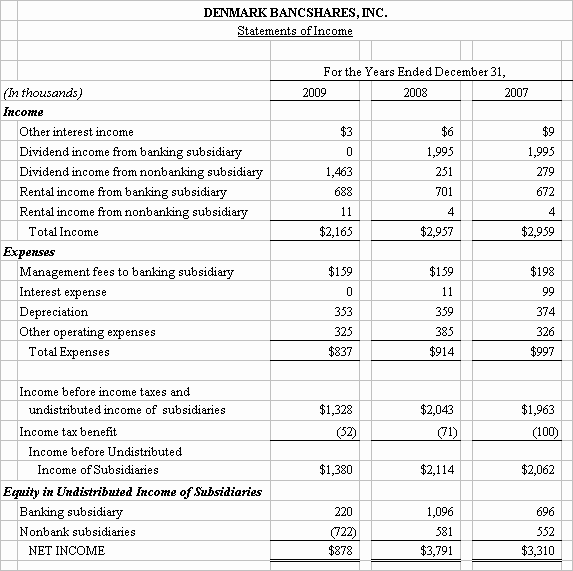
26
NOTES TO CONSOLIDATED FINANCIAL STATEMENTS

NOTE 15 - EMPLOYEE STOCK PURCHASE PLAN
In December of 1998, DBI adopted an Employee Stock Purchase Plan. All DBI employees, except executive officers and members of the board of directors, are afforded the right to purchase a maximum number of shares set from time to time by the board of directors. Rights granted must be exercised during a one-month purchase period prescribed by the board. Rights are exercised at fair market value. There were no rights granted during 2009 and 2008.
27
NOTES TO CONSOLIDATED FINANCIAL STATEMENTS
NOTE 16 - FAIR VALUE MEASUREMENTS
Fair value is the exchange price that would be received for an asset or paid to transfer a liability in the principal or most advantageous market for the asset or liability in a transaction between market participants on the measurement date. Some assets and liabilities are measured on a recurring basis while others are measured on a non-recurring basis, as required by U.S. GAAP which also establishes a fair value hierarchy which requires an entity to maximize the use of observable inputs and minimize the use of unobservable inputs when measuring fair value. Fair value estimates are made at a specific point in time based on relevant market information and information about the financial instrument. The three levels of inputs defined in the standard that may be used to measure fair value are as follows:
Level 1: Quoted prices for identical assets or liabilities in active markets that the entity has the ability to access as of the measurement date.
Level 2: Significant other observable inputs other than Level 1 prices, such as quoted prices for similar assets or liabilities, quoted prices in markets that are not active, and other inputs that are observable or can be corroborated by observable market data.
Level 3: Significant unobservable inputs that are supported by little, if any, market activity. These unobservable inputs reflect estimates that market participants would use in pricing the asset or liability.
DBI used the following methods and significant assumptions to estimate fair value.
Cash, Cash Equivalents and Federal Funds Sold: For cash, cash equivalents and federal funds sold, the carrying amount is a reasonable estimate of fair value.
Investment Securities: Investment securities available-for-sale are recorded at fair value on a recurring basis. The fair value measurement of most of DBI's available-for-sale securities is currently determined by an independent provider using Level 2 inputs. The measurement is based upon quoted prices for similar assets, if available. If quoted prices are not available, fair values are measured using matrix pricing models, or other model based valuation techniques requiring observable inputs other than quoted prices such as yield curves, prepayment speed and default rates. Three of DBI's available-for-sale mortgage-backed securities (MBS) that are secured by non-traditional mortgage loans and one available-for-sale MBS secured by traditional mortgage loans that was downgraded during the second quarter were analyzed by a third party in order to determine an estimated fair value. The estimated fair values were based on discounted cash flow analyses and are considered Level 3 inputs.
Refer to Note 3 - Investment Securities for additional detail on the assumptions used in determining the estimated fair values and additional disclosures regarding DBI's investment securities. For other securities held as investments, fair value equals quoted market price, if available. If a quoted market price is not available, fair value is estimated using quoted market prices for similar securities.
Loans Receivable: The fair value of loans is estimated by discounting the future cash flows using the current rates at which similar loans would be made to borrowers with similar credit ratings and for the same remaining maturities.
Loans Held for Sale: Mortgage loans held for sale are recorded at the lower of cost or market value. The fair value is based on a market commitment for the sale of the loan in the secondary market. These loans are typically sold within one week of funding. DBI classifies mortgage loans held for sale as nonrecurring Level 2 assets. As of December 31, 2009, loans held for sale totaled $654,682.
Impaired Loans: As defined below in the Glossary of Loan Terms section, a loan is considered to be impaired when, based on current information or events, it is probable that not all amounts due will be collected according to the contractual terms of the loan agreement. Impairment is measured based on the fair value of the underlying collateral. The collateral value is determined based on appraisals and other market valuations for similar assets. Under FASB ASC Topic 820, "Fair Value Measurement and Disclosures," the fair value of impaired loans is reported before selling costs of the related collateral, while FASB ASC Topic 310, "Receivables," requires that impaired loans be reported on the balance sheet net of estimated selling costs. Therefore, significant estimated selling costs would result in the reported fair value of impaired loans being greater than the measurement value of impaired loans as maintained on the balance sheet. In most instances, selling costs were estimated for real estate-secured collateral and included broker commissions, legal and title transfer fees and closing costs. Impaired loans are classified as nonrecurring Level 2 assets.
Other Investments: For other investments, the carrying amount is a reasonable estimate of fair value.
Bank Owned Life Insurance: The carrying amount of bank owned life insurance approximates fair value.
28
NOTES TO CONSOLIDATED FINANCIAL STATEMENTS
Other Real Estate Owned: Real estate that DBI has taken control of in partial or full satisfaction of debt is currently valued at fair value. The fair value is determined by analyzing the collateral value of the real estate using appraisals and other market valuations for similar assets less any estimated selling costs. The value carried on the balance sheet of other real estate owned is the estimated fair value of the properties. Other real estate owned is classified as nonrecurring Level 2 assets.
Deposit Liabilities: The fair value of demand deposits, savings accounts and certain money market deposits is the amount payable on demand at the reporting date. The fair value of fixed-maturity certificates of deposit is estimated using the rates currently offered for deposits of similar remaining maturities as well as discounted future cash flows.
Borrowings: Rates currently available to DSB for debt with similar terms and remaining maturities are used to estimate fair value of existing debt.
Commitments to Extend Credit, Standby Letters of Credit and Financial Guarantees Written: The fair value of commitments is estimated using the fees currently charged to enter into similar agreements, taking into account the remaining terms of the agreements and the present creditworthiness of the counterparties. For fixed-rate loan commitments, fair value also considers the difference between current levels of interest rates and the committed rates. The fair value of guarantees and letters of credit is not material.
Assets Recorded at Fair Value on a Recurring Basis
Assets measured at fair value on a recurring basis, are summarized in the table below:


The table below presents a reconciliation and income statement classification of gains and losses for all assets measured on a recurring basis using significant unobservable inputs (Level 3) for the year-ended December 31, 2009.
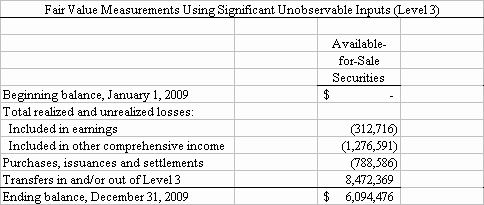
29
NOTES TO CONSOLIDATED FINANCIAL STATEMENTS
Assets Recorded at Fair Value on a Nonrecurring Basis
Assets measured at fair value on a nonrecurring basis, are summarized in the following table:



30
NOTES TO CONSOLIDATED FINANCIAL STATEMENTS
NOTE 17 - REGULATORY MATTERS
DBI and DSB are subject to various regulatory capital requirements administered by the federal and state banking agencies. Failure to meet minimum capital requirements can initiate certain mandatory and possible additional discretionary actions by regulators that, if undertaken, could have a direct material effect on DBI's financial statements. Under capital adequacy guidelines and the regulatory framework for prompt corrective action, DBI must meet specific capital guidelines that involve quantitative measures of DBI's assets, liabilities and certain off-balance-sheet items as calculated under regulatory accounting practices. DBI's capital amounts and classification are also subject to qualitative judgments by the regulators about components, risk weightings and other factors.
Quantitative measures established by regulation to ensure capital adequacy require DBI and DSB to maintain minimum amounts and ratios (set forth in the table below) of Total Capital and Tier 1 Capital (as defined in the regulations) to risk-weighted assets (as defined) and of Tier 1 Capital (as defined) to average assets (as defined). Management believes, as of December 31, 2009, that DBI and DSB meet all capital adequacy requirements to which they are subject.
As of December 31, 2009, the most recent notification from the Federal Deposit Insurance Corporation categorized DSB as well-capitalized under the regulatory framework for prompt corrective action. To be categorized as well-capitalized DSB must maintain minimum total risk-based, Tier 1 risk-based and Tier 1 leverage ratios as set forth in the table.
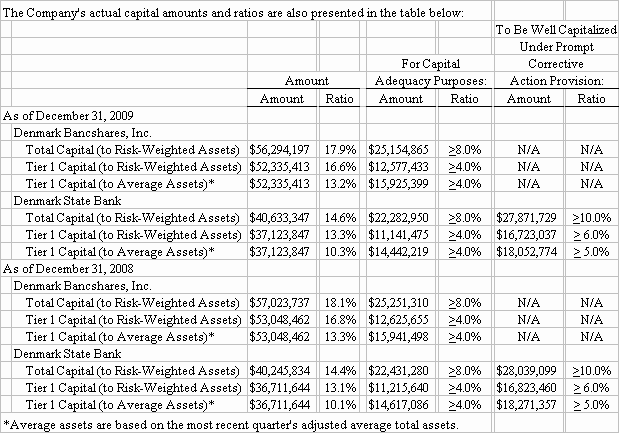
Wisconsin law provides that state chartered banks may declare and pay dividends out of undivided profits but only after provision has been made for all expenses, losses, required reserves, taxes and interest accrued or due from the bank. Payment of dividends in some circumstances may require the written consent of the Division.
31
MANAGEMENT'S DISCUSSION AND ANALYSIS
Background
Management's discussion and analysis of financial condition and results of operations of Denmark Bancshares, Inc. and its subsidiaries ("DBI"), is intended as a review of significant factors affecting DBI's consolidated results of operations during the three-year period ended December 31, 2009, and DBI's consolidated financial condition at the end of each year of the two-year period ended December 31, 2009. Management evaluated subsequent events as they relate to the financial statements as of February 23, 2010. This discussion should be read in conjunction with the "CONSOLIDATED FINANCIAL STATEMENTS" including the accompanying notes, and the "SELECTED FINANCIAL DATA" presented elsewhere in this report. DBI's subsidiaries are the Denmark State Bank ("DSB"), Denmark Agricultural Credit Corporation ("DACC"), DBI Properties, Inc. ("Properties") and the McDonald-Zeamer Insurance Agency, Inc. ("McDonald"). On January 2, 2007, McDonald sold their insurance book of business and agreed to exit the insurance business for a period of three years. DBI Properties, Inc. was formed in February 2009 for the purpose of holding certain foreclosed properties.
This report may contain certain forward-looking statements, including without limitation, statements regarding results of operations, the adequacy of the allowance for loan and lease losses, the amounts of charge-offs and recoveries, capital to assets ratios, capacity for paying dividends and liquidity. These forward-looking statements are inherently uncertain and actual results may differ from Management's expectations, The following factors, which, among others, could impact current and future performance include but are not limited to: (i) adverse changes in asset quality and resulting credit risk-related losses and expenses; (ii) adverse changes in the local economy; (iii) fluctuations in market rates and prices which can negatively affect net interest margin, asset valuations and expense expectations; and (iv) changes in regulatory requirements of federal and state agencies applicable to banks and bank holding companies, which could have materially adverse effects on DBI's future operating results. When relying on forward-looking statements to make decisions with respect to DBI, investors and others are cautioned to consider these and other risks and uncertainties including the risks described under the caption "Risk Facotrs" in our Annual Report on Form 10-K for the year-ended December 31, 2009. All forward-looking statements contained in this report are based upon information presently available and DBI assumes no obligation to update any forward-looking statements.
Critical Accounting Policies
The accounting and reporting policies of DBI are in accordance with accounting principles generally accepted in the United States of America and conform to general practices in the banking industry. The preparation of financial statements in conformity with these principles requires management to make estimates and assumptions that affect the reported amounts of assets and liabilities at the date of the financial statements, and the reported amounts of revenues and expenses during the reporting period. These estimates and assumptions are based on information available at the date of the financial statements. Certain policies inherently have a greater reliance on the use of estimates, assumptions, and judgments and as such have a greater possibility of producing results that could be materially different than originally reported. Management believes that DBI's critical accounting policies are those relating to the allowance for loan and lease losses.
Allowance for Loan and Lease Losses
The allowance for loan and lease losses ("ALLL") is an estimate of the losses that may be sustained in the loan and lease portfolio. The allowance is based on two basic principles of accounting: (1) Statement of Financial Accounting Standards ("SFAS") No. 5, "Accounting for Contingencies," which has been incorporated into FASB ASC Topic 450, "Contingencies" and requires that losses be accrued when they are probable of occurring and estimable, and (2) SFAS No. 114, "Accounting by Creditors for Impairment of a Loan," which has been incorporated into FASB ASC Topic 310, "Receivables," which requires that the loan be categorized as impaired when it is probable that DBI will not collect all principal and interest payments according to the loan's or lease's contractual terms. Guidelines for determining allowances for loan losses are also provided in the ASC 310-10-S99, "Accounting for Loan Losses by Registrants Engaged In Lending Activities," and the Federal Financial Institutions Examination Council's interagency guidance, "Interagency Policy Statement on the Allowance for Loan and Lease Losses" (the "FFIEC Policy Statement").
DSB's and DACC's boards of directors have approved policies to provide management with a systematic methodology to determine an appropriate allowance for loan and lease losses. This methodology includes a systematic loan grading system that requires quarterly reviews, identification of loans to be evaluated on an individual basis for impairment, results of independent reviews of asset quality and the adequacy of the allowance by regulatory agencies as an integral part of their examination process, consideration of current trends and volume of total nonperforming, past due, nonaccrual and potential problem loans, and consideration of national and local economic trends and industry conditions.
In applying the methodology, nonaccrual loans, restructured loans and potential problem loans, above a certain size, are reviewed to determine if they are impaired. Impaired loans are individually analyzed and an allowance amount is calculated for each one of these loans, based on the estimated fair value of collateral, in conjunction with FAS 114. Loans that are not impaired are segmented into groups by type of loan. The following loan types are utilized so that each segment of loans will have similar risk factors; 1) residential real estate, 2) agricultural real estate, 3) commercial real estate, 4) agricultural, 5) commercial, 6) consumer installment, and 7) other. In addition, based on internal reviews and external reviews performed by regulatory authorities, DSB and DACC further segregate loans that are not impaired by loan risk classification within each type of loan based on an assessment of risk for a particular loan.
32
MANAGEMENT'S DISCUSSION AND ANALYSIS
The applicable risk classifications are "special mention" and "substandard". A "substandard" loan is a loan that is inadequately protected by the current net worth and paying capacity of the borrower or of any collateral. Loans classified "substandard" have well-defined weaknesses that jeopardize liquidation and are characterized by the distinct possibility that some loss will be sustained if the deficiencies are not corrected
.Loans classified "special mention" are one step above substandard; these loans contain some weakness which if not corrected or improved upon could lead to further deterioration and a lower rating. Risk factor percentages are applied to the identified segments of each of the nonclassified and classified portions of the portfolios to calculate an allowance in conjunction with ASC Topic 450. These risk factor percentages are based on historical loan loss experience adjusted for current economic conditions and trends and internal loan quality trends.
The foregoing calculations in accordance with ASC Topics 310 and 450 are used to confirm the adequacy and appropriateness of the ALLL as developed through provisions for credit losses charged to expense, recognizing that the ALLL represents an aggregation of judgments and estimates by management. Such calculations also influence the amount of future provisions for credit losses charged to expense, pending reapplication of the described systematic methodology.
Intangible Assets
DBI has a core deposit intangible asset that was originated in connection with DSB's expansion through an acquisition of an established branch operation in 1997. The acquisition did not meet the definition of a business combination in accordance with ASC 805 - Accounting for Business Combinations Occurring in Periods Beginning before December 15, 2008. As such, DBI continues to amortize the intangible asset related to the acquisition over a period of fifteen years. Annually DBI reviews the intangible assets for impairment and records an impairment charge, if any, to earnings.
Glossary of Loan Terms
Impaired Loan - A loan is impaired when, based on current information and events, it is probable that not all amounts due will be collected according to the contractual terms of the loan agreement. Impaired loans are measured at the estimated fair value of the collateral. If the estimated fair value of the impaired loan is less than the recorded investment in the loan, an impairment is recognized by creating a valuation allowance.
Nonaccrual Loan - DSB's policy is to place in nonaccrual status all loans which are contractually past due 90 days or more as to any payment of principal or interest and all other loans as to which reasonable doubt exists as to the full, timely collection of interest or principal based on management's view of the financial condition of the borrower. When a loan is placed on nonaccrual, all interest previously accrued but not collected is reversed against current period interest income. Income on such loans is then recognized only to the extent that cash is received and where the future collection of principal is probable. Interest accruals are resumed on such loans only when they are brought fully current with respect to interest and principal and when, in the judgment of management, the loans are estimated to be fully collectible as to both principal and interest.
Non-Performing Assets - Non-performing assets include nonaccrual loans as defined above and real and personal properties acquired in satisfaction of debts previously owed.
Past Due Accruing Loans - A loan on which all or part of a scheduled payment is delinquent by more than 30 days but less than 90 days past due, except loans that are considered nonaccrual.
Potential Problem Loans - Potential problem loans are accruing loans in which there exists doubt as to the ability of the borrower to comply with present loan repayment terms. Management's decision to place loans in this category does not necessarily mean that DBI expects losses to occur on these loans, but that management recognizes that a higher degree of risk is associated with these accruing loans and they deserve closer scrutiny.
Restructured Loans - Restructured loans involve the granting of some concession to the borrower involving the modification of terms of the loan, such as changes in the payment schedule, the amortization term, the interest rate, or a combination of these.
Risk Rating - Risk rating, which is also sometimes referred to as loan grade, is the credit quality grade assigned to each loan. Loans are assigned a risk rating upon origination. Lenders and credit review analysts conduct periodic reviews and evaluations and make adjustments to the assigned grades when appropriate. The range of categories from the best quality to worst is as follows: highest quality, solid quality, some weakness, inherent industry weakness, special mention, substandard, doubtful and loss. Impaired loans are generally assigned a substandard risk grade.
Special Mention Loans - Loans classified "special mention" are one step above substandard loans as described below. These loans contain some weakness, which if not corrected or improved upon could lead to further deterioration and a lower rating.
Substandard - A "substandard" loan is a loan that is inadequately protected by the current net worth and paying capacity of the borrower or the value of any collateral. Loans classified "substandard" have well-defined weaknesses that jeopardize prospects for liquidation and are characterized by the distinct possibility that some loss will be sustained if the deficiencies are not corrected.
33
MANAGEMENT'S DISCUSSION AND ANALYSIS
OVERVIEW
DBI experienced very disappointing earnings in 2009 recording $878,323 of net income which was 77% lower than 2008 earnings. This is by far the lowest level of earnings since 2000 and is a direct result of poor asset quality. DBI's profitability is largely dependent on the loan portfolio. The loan quality issues effect the profitability of DBI in the form of higher provision for credit losses, direct expenses associated with the acquisition and disposition of acquired properties and the interest income that is foregone on nonperforming loans.
Charge-offs on loans totaled more than $5.9 million in 2009 or $4.9 million higher than one year earlier as a result of poor underwriting standards in place when the loans were originated, the deterioration of the housing and commercial real estate markets and the Wisconsin economy in general. The increased charge-offs and continuing elevated levels of nonperforming and problem loans required a charge to income of $5.5 million in provision for credit losses. This represented an increase of $4.5 million over the 2008 provision expense and represented 1.84% of average loans outstanding during 2009. The construction and land development portfolio performed the worst as charge-offs were $2.5 million representing over 12% of the prior year-end balance for that category. The commercial real estate portfolio also sustained heavy losses with $2 million in charge-offs or almost 4% of the 2008 year-end balance.
Management formed a special asset group of three lenders to closely monitor problem credits and initiate foreclosure proceedings, personal property asset repossessions and disposition of acquired properties. DBI disposed of 22 real estate properties totaling $1.4 million and acquired 14 properties valued at $2.3 million in 2009. At year-end 2009 DBI owned eight properties valued at approximately $1.7 million. DBI recorded $501,288 of expenses associated with foreclosed properties during 2009 compared to $915,940 during 2008. While this represented a decrease of $414,652, or 45% lower than one year earlier. The expenses were, in management's opinion, still unacceptably high and do not include the additional costs of management salaries and benefits for workout specialists. Problem assets require an inordinate amount of management's time and attention on a regular basis.
As of December 31, 2009, nonaccrual loans were $12.8 million representing 4.3% of total loans. Nonperforming assets (nonaccrual loans plus acquired properties) totaled $14.5 million at year-end and represented 3.5% of total assets. Nonperforming assets declined by $1.9 million compared to the prior year-end but improving the credit quality of the loan portfolio and further reducing the level of nonperforming assets remains the number one priority for 2010.
DBI's loan portfolio contains $216 million or 73% of total loans secured by real estate. The decline in residential and commercial real estate values throughout our market area has caused some loans to be under collateralized. DBI also has a niche in agricultural lending in its market area. The agricultural loan portfolio (including loans secured by farmland) was $97 million at year-end and represents nearly 33% of total loans. The agricultural economy experiences cyclical fluctuations and is discussed below. DBI experienced net recoveries during the last four years on the agricultural portfolio and a low level of past due loans. The commercial real estate portfolio was $58 million or 20% of total loans. The construction and land development portfolio has declined 45% from a high of $29 million in 2005 to $16 million at year-end. While the collapse of the housing market led to the economic downturn, commercial real estate has become the next problem area. Past due (30 days and over, including nonaccrual) commercial real estate and construction and land development loans totaled almost $11 million and represent 67% of DBI's total past due loans and 3.7% of total loans.
DBI also experienced asset quality issues in the investment portfolio and recognized OTTI credit losses totaling $312,716 relating to two non-agency residential mortgage-backed securities with loans concentrated in California which experienced severe housing price declines. These securities were rated AAA when purchased but are backed by option adjustable rate mortgages (ARMs). Many of these ARMs are set to recast interest rates this year and consequently borrowers may lack the ability to pay their adjusted mortgage payments which could lead to additional credit losses.
FDIC insurance premiums in 2009 increased by $337,432 compared to 2008 and totaled $617,432. The premiums included a five basis point special assessment. The FDIC also increased the risk-based assessment rate by three basis points for 2010 and required banks to prepay three years of their risk-based deposit insurance on December 30, 2009. The number of failed FDIC insured banks increased from 25 in 2008 to 140 in 2009. This represented the most bank failures since 1992 when 179 banks failed. The number of 2010 bank failures is likely to remain high as sixteen banks have already failed as of mid February 2010 and it is possible the FDIC may need to impose another special assessment in 2010 if the deposit insurance fund goes lower than the FDIC expects. The FDIC extended the $250,000 per depositor coverage limit through 2013.
During 2009, many other financial institutions experienced asset quality issues and this made adequate capital and liquidity increasingly important in the industry. Those institutions with adequate capital and liquidity survived and many troubled institutions sought to raise additional capital, shrunk their balance sheets, discontinued or lowered dividend payments, sold securities to realize gains in their portfolios, aggressively sought core deposits to replace brokered deposits and took other measures to improve capital and liquidity ratios.
34
MANAGEMENT'S DISCUSSION AND ANALYSIS
DBI declared dividends totaling $14.50 which exceeded earnings per share of $7.38 in 2009. However DBI's capital ratios fell only slightly as total assets declined by nearly $6 million. DBI continues to maintain a strong capital position in relation to its peers and that capital provides a safety cushion in the event of additional loan charge-offs. DBI's leverage ratio (core capital as a percent of average assets) at year-end 2009 was 13.2% compared to 8.2% for peer bank holding companies. Core capital as a percent of risk-based assets was 16.6% compared to the peer group average of 11.1%. Total capital as a percent of risk-based assets was 17.9% compared to the peer group average of 12.7%. The peer group data was obtained from the latest available holding company data as of September 30, 2009, from the Federal Reserve's Bank Holding Company Performance Report, and consists of 91 bank holding companies with total assets less than $500 million.
DBI maintains liquid assets and established lines of credit to meet its liquidity needs. DBI has a Contingency Funding Plan that, among other things, identifies liquidity risks, requires reporting and stress testing and defines a liquidity crisis. The plan reviews the asset and liability based sources and uses of liquidity for DBI, DSB and DACC. DSB relies on a stable mix of funding sources and had no brokered deposits as of year-end. DSB's net noncore fund dependence as of December 31, 2009, was 17%. This compares favorably to the peer group average of 29% obtained form the Uniform Bank Performance Report of banks with total assets between $250 million and $1 billion as of year-end 2009. Management believes DBI's liquidity position is adequate.
DBI measures how efficiently it is generating net income by comparing its spending on noninterest overhead expenses to its operating income (the resulting computation is called the efficiency ratio). A lower ratio indicates better efficiency. The efficiency ratio was 60% for 2009, compared to 64% and 63% for the years ended 2008 and 2007, respectively. The 2009 and 2008 efficiency ratios, calculated without the nonrecurring expenses of $501,288 and $915,940, respectively, associated with foreclosed properties were 57% and 59% respectively. The significant items of noninterest expenses are discussed on the following pages.
The local economic conditions prevailing at year-end 2009 varied by county, but each county experienced higher unemployment than one year earlier. The area's unemployment rates in December 2009 were slightly below the national unemployment rate and ranged from a low of 7.3% in Brown County to a high of 9.7% in Manitowoc County compared to 5.3% and 6.2%, respectively, one year ago. For the first time in four years Brown County experienced an increase in the number of home sales which were up 1% to 2,369 units, compared to 2,338 during 2008. The median price of a home in Brown County fell 8% to $135,000, compared to $147,100 during 2008.
The agricultural economy experienced one of its toughest years since the early 1970s. Milk prices plunged about 32% in 2009 and averaged $13 per hundred weight compared to $19 per hundred weight in 2008 while feed and energy prices dropped only marginally. Wisconsin farmers' net income in 2009 fell an estimated $1.5 billion or 56% lower than during 2008. The agricultural economy is expected to improve in 2010 as the national dairy cow herd will shrink and milk prices are expected to average about $17.50 per hundred weight or $4.50 higher than 2009. Wisconsin farmers enter this expected downturn with strong balance sheets to help weather the storm. At the beginning of 2008, Wisconsin dairy farm assets totaled $21 billion and farm debt was only $3.1 billion. Equity was eroded in 2009 as farm revenue fell far short of operating costs and the debt-to-asset ratio of Wisconsin farmers rose from about 15% to 18% as the value of dairy farm assets fell to $19.3 billion while debt increased to $3.4 billion.
The U.S. economy fell into what many economists are calling the "Great Recession" of 2008-2009 which included three consecutive quarters of declining real GDP growth and the unemployment rate exceeded 10% for only the second time since World War II. U.S. housing starts for the first and second quarters of 2009 were only about a quarter of those in 2005. U.S. inflation was relatively low and DBI believes excess business capacity and high unemployment should limit overall inflation in the immediate future. Government stimulus plans were created to spur the auto and housing sectors as a "cash for clunkers" rebate of $4,500 and an $8,000 tax credit for first-time home buyers were introduced. The challenges in 2010 will include high residual unemployment, continuing credit problems for small businesses, uncertainty about government fiscal and monetary policies and increased regulation on financial institutions.
Interest rates remained low in 2009 due to the continued stressed economic conditions. The Federal Reserve kept the federal funds rate (inter-bank lending rate) at 0% - 0.25% throughout all of 2009 and the prime rate interest set by banks remained at 3.25%. In January 2010 financial regulators issued an advisory to remind financial institutions of supervisory expectations regarding sound practices for managing interest rate risk (IRR). Regulators warned that in the current environment of historically low short-term interest rates, it is important for institutions to have robust processes for measuring and, where necessary, mitigating their exposure to potential increases in interest rates. Current financial market and economic conditions present significant risk management challenges to institutions of all sizes. For a number of institutions, increased loan losses and sharp declines in the values of some securities portfolios are placing downward pressure on capital and earnings. In this challenging environment, funding longer-term assets with shorter-term liabilities can generate current earnings, but also poses risks to an institution's capital and long-term earnings. DBI's Asset Liability Committee is closely monitoring market interest rates and adjusting loan and deposit rates and terms accordingly. DBI has limited recent investment purchase maturities to 5 years or less except for a limited amount of variable rate securities. Management believes DBI's IRR practices are functioning within the regulatory guidelines.
35
MANAGEMENT'S DISCUSSION AND ANALYSIS
Despite the many difficult problems experienced by DBI during 2009 there were numerous positive results that were overshadowed by the credit quality issues. Following are some of the encouraging events of 2009:
- The Board of Directors developed a management succession plan and, as part of that plan, promoted Jill Feiler as President of DSB effective January 1, 2010, with Jack Olsen retaining his position as CEO, Carl Laveck as CCO and Dennis Heim as CFO.
- Denmark State Bank successfully celebrated its 100-year anniversary with product promotions throughout the month of March.
- DBI's net interest spread of 3.78% was the highest recorded since 2004.
- The Maribel office was remodeled to improve staff efficiency while maintaining a branch location that allows us to meet the needs of our customers in the area. Office space is now available to lease to interested tenants at both the Maribel and Wrightstown offices.
- DBI was able to maintain its dividend during a year that saw the fewest dividend increases and the most decreases since Standard & Poor's began keeping track in 1955. The dividend reductions primarily came from the financial institutions sector, as banks looked to shore up their balance sheets or were mandated to cut the payouts as a provision of accepting TARP funds or by their regulators. The reductions cost investors a cumulative $58 billion.
- DSB developed a consistent radio marketing plan that focused on branding the DSB name and successfully acquired new customers and generated new loans and deposits.
- Formulated a new three year strategic plan through 2012 which produced four strategic priorities and developed a written action plan to accomplish these goals
- DBI's common stock price held its value fairly well considering the fall in earnings and asset quality problems and ended the year trading near book value in limited volume.
- DBI reduced salaries and benefits expense by $369,000 or 6%.
- DBI reduced occupancy expenses by $171,000 or 13%.
- DBI increased income from mortgage originations by 340% from $65,000 in 2008 to $285,000 in 2009.
Management has identified the following significant challenges and opportunities for 2010:
- Continuing to reduce the level of nonperforming assets as a failure to do so will result in lower net interest spread and higher expenses associated with acquired properties.
- Maintaining adequate capital as a cushion against a possible rise in nonperforming assets or an unexpected rise in charge-offs.
- Maintaining adequate liquidity to meet the credit needs of our borrowers and fluctuations in deposits.
- Pressure on net interest margin in this low interest rate environment as deposit rates are near a floor. It is not anticipated that the Fed will raise interest rates until later in 2010, if at all, but most agree the Fed will move rates up aggressively when the upward trend begins.
- Continued increases in FDIC insurance premiums including another special assessment in 2010 if the number of bank failures continues at current level or there are large losses sustained by the Deposit Insurance fund.
- Complying with a substantial number of new regulations, including Regulation Z (Truth in Lending) affecting mortgage disclosures, Regulation DD (Truth in Savings) concerning overdraft services and fees, The Credit CARD Act of 2009 and a variety of proposed regulations, in addition to the possibility of a new Consumer Financial Protection Agency.
- Continuing to lend to small businesses and consumers while satisfying field examiners that current underwriting standards are prudent in an increasingly difficult regulatory exam environment that saw the number of formal and informal written agreements increase dramatically during the last two years.
- Improving DSB's online branch with a revised interactive web site that includes online account opening of loans and deposits and continued emphasis on enhancing electronic delivery of products and services.
36
MANAGEMENT'S DISCUSSION AND ANALYSIS
RESULTS OF OPERATIONS

Earnings Performance Summary
DBI recorded net income of $878,323 in 2009. This represents a decrease of $2,912,910 or 77% compared to 2008 earnings. The decrease in net income is primarily attributable to an increase in the provision for loan losses of $4.5 million as well as a write-down of $312,716 on available-for-sale securities determined to be other than temporarily impaired. Total interest income decreased by $2,918,565 or 12% lower than 2008 while total interest expense fell by $2,987,882 or 31% lower than 2008. This resulted in the increase of $69,317 in net interest income for the year ended December 31, 2009, compared to one year earlier.
Net income during 2008 increased $481,078 or 15% compared to 2007 earnings. The increase in net income in 2008 was primarily attributable to an increase in net interest income with a lower provision for income taxes. Total interest income decreased by $2,118,267 or 8% lower than 2007 while total interest expense fell by $3,210,192 or 25% lower than 2007. This resulted in the increase of $1,091,925 in net interest income for the year ended December 31, 2008 compared to one year earlier.
On a per share basis, net income was $7.38 in 2009 compared with $31.84 in 2008 and $27.80 in 2007. Return on average assets for DBI was 0.22% in 2009 compared to 0.96% in 2008 and 0.84% in 2007. Return on average equity in 2009 was 1.7% compared to 7.2% and 6.5% in 2008 and 2007, respectively.
Income Taxes
For the years ended December 31, 2009, 2008 and 2007, DBI recorded combined federal and state income tax benefit of $656,174, and provisions of $383,982 and $865,802, respectively. These reflect effective income tax rates of (295%), 9% and 21%, in 2009, 2008 and 2007, respectively, which are less than DBI's combined statutory tax rate of 39%. The lower effective income tax rates are primarily attributable to non-taxable interest income earned on state and local government investment securities in relation to pre-tax income. DBI's 2008 provision for income taxes was reduced by $355,289 from a tax refund.
37
MANAGEMENT'S DISCUSSION AND ANALYSIS
DBI's consolidated average statements of financial condition, interest earned and interest paid, and the average interest rates earned and paid for each of the last three years are:
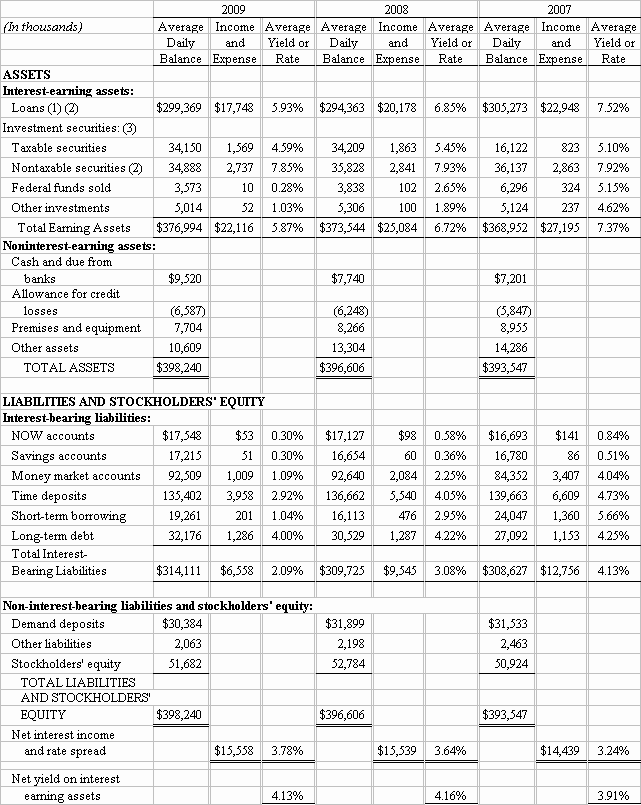
- Nonaccrual loans are included in the average daily balance figure, but interest income associated with these loans is recognized under the cash basis method of accounting.
- The yield on tax-exempt loans and securities is computed on a tax-equivalent basis using a tax rate of 34%.
- Securities are shown at amortized cost.
38
MANAGEMENT'S DISCUSSION AND ANALYSIS
Net Interest Income
The following table sets forth a summary of the changes in interest earned and interest paid resulting from changes in volume and changes in rates. Changes that are not due solely to volume or rate have been allocated to rate.
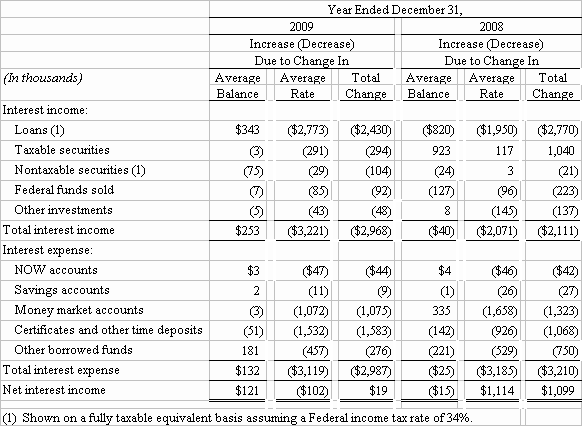
Net interest income is the largest component of DBI's operating income. Net interest income represents the difference between interest income on earning assets, such as loans and securities, and the interest expense on deposits and other borrowed funds. Net interest income is affected by fluctuations in interest rates and by changes in the volume of earning assets and interest-bearing liabilities outstanding. Net interest income in the following discussion has been adjusted to a taxable equivalent level (tax-exempt interest has been increased to a level that would yield the same after-tax income had that income been subject to tax at a 34% tax rate) and therefore differs from the amount reported in the Consolidated Statements of Income.
Net interest income on a taxable equivalent basis remained nearly stable, with a slight increase being recognized between 2009 and 2008. The increase is the result of an improvement in the net interest spread of 14 basis points over the prior year. Net interest spread is the difference between the average yield earned on assets and the average rate incurred on liabilities. The increase is mostly attributable to a lower overall cost of funds which declined 99 basis points from 3.08% in 2008 to 2.09% in 2009. This improvement was primarily due to a decline in money market rates of 116 basis points along with the decline in the cost of certificates of deposit of 113 basis points from prior year end. This more than offset the decrease in the yield earned on assets which declined 85 basis points. The tax-equivalent net interest spread was 3.78% during 2009, compared to 3.64% and 3.24% during 2008 and 2007, respectively.
Net interest income on a taxable equivalent basis increased 8% or nearly $1.1 million from 2007 to 2008. The increase is the result of an improvement in the net interest spread of 40 basis points over the prior year. Net interest spread is the difference between the average yield earned on assets and the average rate incurred on liabilities. The increase is mostly attributable to a lower overall cost of funds which declined 105 basis points from 4.13% in 2007 to 3.08% in 2008. This improvement was primarily due to a decline in money market rates of 179 basis points along with the decline in the cost of certificates of deposit of 68 basis points from prior year end.
39
MANAGEMENT'S DISCUSSION AND ANALYSIS
Noninterest Income

Noninterest income in 2009 totaled $1,875,242, an increase of $274,139 or 17% over 2008. The increase is primarily the result of loan sales gains of $285,494 recognized during 2009. DSB sold $26.1 million of residential real estate loans to the secondary mortgage market during 2009 compared to $5.9 million in 2008. As a result, gains on the sale of the loans increased $220,555 or 338% over gains recorded in 2008. In addition, service fees and commissions increased $61,037 or 7% to $894,581 during 2009. Service charges and overdraft fees on deposit accounts increased by $89,356 primarily due to increased overdraft charges on deposit accounts and higher business checking accounts service charges as a result of lower earnings credits. Commissions recorded from the sales of mutual funds, annuities, common stocks and insurance decreased by $35,011. Investment security gains of $38,444 were realized in 2009 due to a restructuring of the portfolio as compared to $31,486 in 2008.
Noninterest income in 2008 totaled $1,601,103, a decrease of $230,426 or 13% from 2007. The decrease is primarily the result of the absence of the non-recurring income from the sale of the book of business of McDonald during January 2007 which resulted in a realized gain of $380,881. This decline was partially offset by an increase in service fees and commissions of $48,171 and investment security gains of $31,486. Service charges and overdraft fees on deposit accounts increased by $27,369 primarily as a result of increased service charges on business checking accounts as a result of lower earnings credits. Commissions recognized from the sales of mutual funds, annuities, common stocks and insurance increased by $20,687. Investment security gains of $31,486 were realized in 2008 due to a restructuring of the portfolio. DSB sold $5.9 million of residential real estate loans to the secondary mortgage market during 2008 compared to $3.2 million in 2007. As a result, gains on the sale of the loans increased $19,732 in 2008 or 44% over the gains reported in 2007.
Other-than-Temporary Impairment Losses
In April 2009, the FASB issued guidance under Topic 320, which is discussed in Note 1 to the financial statements above, to make the guidance more operational and to improve the presentation and disclosure of other-than-temporary impairments (OTTI) on debt and equity securities in the financial statements. Under Topic 320 if the determination is made that there is other-than-temporary impairment and that a credit loss exists but the entity does not intend to sell the debt security and it is not more likely than not that the entity will be required to sell the debt security before the anticipated recovery of its remaining amortized cost basis, the presentation and amount of the OTTI recognized in the statement of earnings is changed. Only the portion related to the credit loss is recognized in the statement of earnings and the impairment related to all other factors is recognized in other comprehensive income.
Two available-for-sale securities that were analyzed for OTTI were determined to be other-than-temporarily impaired. A portion of the unrealized loss was found to be related to credit loss. As such, $312,716 was written off through the income statement in 2009. Additional details on the analysis that was performed on these securities can be found in Note 3 - Investment Securities.
Noninterest Expense
Total noninterest expense was $10,438,192, a decrease of $516,694 or 5% in 2009. Net losses recorded on the sales or write-downs of other real estate properties acquired through foreclosure decreased $476,497 in 2009 to $29,687 when compared to 2008. Expenses incurred on acquired properties totaled $471,601 in 2009, an increase of $61,845 over 2008. These expenses consisted primarily of costs for real estate taxes, repairs and maintenance, insurance and legal. This resulted in a net improvement of costs related to acquired properties of $414,652 in 2009 from the prior year.
40
MANAGEMENT'S DISCUSSION AND ANALYSIS
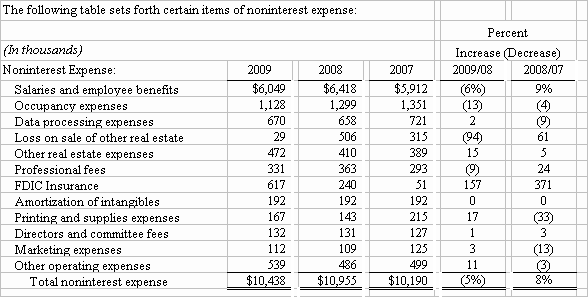
Salaries and employee benefits expense decreased $368,986 or 6% in 2009. The decrease is primarily attributable to a decrease in salaries and wages of $359,382 or 7% along with a reduction of $155,074 in DBI's contribution to employees' 401(k) plans. The discretionary portion of the 401(k) contribution was 4% in 2008. Given the financial performance during 2009, the Board of Directors voted against funding the discretionary contribution. The number of full-time equivalent employees declined from 95 in 2008 to 94 in 2009. These cost savings were partially offset by an increase in health insurance related expenses of $149,673 or 18% in 2009 from $843,961 in 2008.
Occupancy expenses decreased by $170,670 or 13% in 2009 primarily as a result of lower depreciation expense which fell by $109,281. That downward trend will continue in 2010 as DBI has no major capital improvement plans. Also contributing to the improvement in occupancy expenses was a decline of $45,459 related to equipment maintenance costs.
Professional fees decreased by $32,066 or 9% during 2009. Professional fees include expenditures for legal, audit, compliance, tax and other professional services. The decrease was primarily attributable to a reduction in expenses related to accounting and auditing services of $46,237 in 2009 along with a decline in legal and recording expenses of $18,273. These improvements were partially offset by an increase in consulting fees of $38,142 due primarily to expenses of approximately $24,000 for an external audit of information technology during 2009.
FDIC insurance premiums increased by $377,432 during 2009 compared to 2008. Significant increases were anticipated given that the premium was going to go from 7 basis points in 2008 to 14 basis points in 2009. In addition, a special assessment was announced during 2009 to help fund the costs of recent bank failures that were depleting the insurance fund. DBI's quarterly premiums averaged $115,019 during 2009 as compared to $59,098 for 2008. The special assessment paid during the third quarter of 2009 was $161,185. As an alternative to an additional special assessment given the strain that bank failures had on the fund, the FDIC required banks to prepay premiums for the 4th quarter of 2009 through the 4th quarter of 2012 as of December 30, 2009. The total amount DBI prepaid was $1,762,898.
In 2008, total noninterest expense was $10,954,886, an increase of $765,241 or 8% from 2007. Salaries and employee benefits expense increased $506,044 or 9% in 2008. The increase is partly attributable to an increase in full-time equivalent employees from 90 in 2007 to 95 in 2008. Salaries and wages increased by $432,187 or 10% in 2008 and related retirement plan contribution increased $56,719. Occupancy expenses decreased by $52,097 in 2008 primarily as a result of lower depreciation expense which fell $94,946from 2007. This decrease was partially offset by an increase in building maintenance expenses which were $42,940 higher in 2008 than in 2007.
Data processing expenses decreased $62,974 or 9% in 2008 primarily due to the fact that during the first quarter of 2007, DBI was still paying fees to both Fiserv and Metavante during the systems conversion. This overlap of payments did not occur during 2008.
Professional fees increased by $70,272 or 24% during 2008. Professional fees include expenditures for legal, audit, compliance, tax and other professional services. The increase is primarily attributable to the expenses related to internal audit and compliance consulting expenses.
41
MANAGEMENT'S DISCUSSION AND ANALYSIS
Expenses incurred on acquired properties totaled $409,756 in 2008, an increase of $20,476 compared to 2007 expenses totaling $389,280. In addition to the carrying costs of acquired properties, DSB recorded $506,184 of losses on the sales (or write-downs) of other real estate properties acquired through foreclosure during 2008. This represented an increase of $190,880 compared to 2007 and was the result of increased efforts to dispose of these properties.
FDIC insurance premiums increased by $189,035 during 2008. The Federal Deposit Insurance Reform Act of 2005 implemented risk-based pricing along with a one-time assessment credit to recognize institutions' past contributions to the fund. DSB's assessment credit was exhausted during the second quarter of 2008 resulting in the increase in premiums.
FINANCIAL CONDITION
The following table sets forth certain assets and liabilities of DBI on a consolidated basis as of the end of each of the three most recent fiscal years and period-to-period percentage increases (decreases):
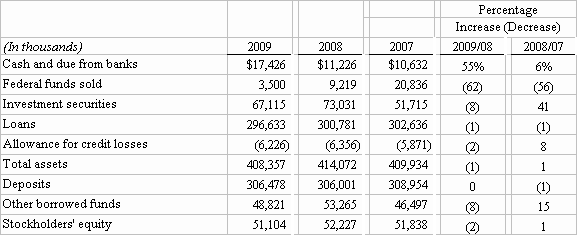
Total assets at December 31, 2009, were $408 million. This represents a decrease of $5.7 million, or 1% lower than year-end 2008. Investment securities decreased by $5.9 million or 8% in 2009 as compared to year-end 2008. Federal funds sold (overnight investments with correspondent banks) decreased by $5.7 million in 2009. Cash and due from banks increased $6.2 million or 55% as of year-end 2009. This included a balance of $5 million in an insured money market product earning 0.75% which is 50 basis points over the rate earned on federal funds sold. Total loans (excluding loans held for sale) decreased $4.1 million or 1% compared to year-end 2008. Management attributes the decline in the loan portfolio to the charge-offs recorded, a softening housing market, tighter internal credit underwriting standards, strong local competition for loans and a focus on problem credits within the portfolio. The high level of problem loans and the emphasis to reduce the level of acquired properties required a significant amount of time devoted to collections and management of acquired properties. Total deposits remained relatively stable during 2009 at $306 million. Other borrowed funds decreased $4.4 million or 8% in 2009.
Loans
Loans secured by residential mortgages totaled $87 million or 29% of total loans which represented DBI's largest single category of loans at the end of 2009. These loans are substantially all fixed rate loans with original terms of one, three, five and ten years. At the end of the original term the notes are renewed, subject to updated credit and collateral valuation information but generally without fees or closing costs to the customer. Virtually all of these notes amortize principal indebtedness over a fifteen to thirty-year period, and are repriceable at fixed rates that generally follow prevailing longer-term rates. DBI offers a Hometown Mortgage product to consumers and held $16.1 million of 10-year fixed rate mortgages yielding 5.62% at year-end 2009. These loans will be held in the portfolio and require amortization over 30 years and a balloon payment at the end of the 10-year term. During 2009, $814,246 of loans secured by residential properties were transferred to acquired properties and $1,105,430 of charge-offs were recorded on loans secured by residential properties. Also, during 2009 $26.1 million of residential mortgages were sold on the secondary market. Of those loans sold on the secondary market, $6 million was from existing DSB loans that were refinanced. Management attributes the $6.7 million decline in 2009 in residential mortgages to the refinancings, the transfers to acquired properties and the charge-offs.
42
MANAGEMENT'S DISCUSSION AND ANALYSIS
Commercial real estate loans and other commercial loans decreased by $2.4 million in 2009. DBI transferred $1,189,637 of commercial real estate loans to acquired properties and recorded charge-offs of $2,258,963 on commercial loans during 2009. Management attributes the decline in the commercial portfolio to these factors as well as the continued difficult economic conditions during the year.
Construction loans declined by $4.5 million in 2009 compared to 2008. The construction portfolio consists mainly of development loans for residential properties. DBI recorded charge-offs of $2,458,209 on construction loans during 2009.
At December 31, 2009, $96.8 million or 33% of DBI's outstanding loans were deemed "agriculture-related", constituting the highest industrial concentration in the portfolio. Of these loans, over 90% relate directly to the dairy farming industry. Most of these notes are written on a one-year basis, which allows DBI to review credit information and collateral values annually to ensure continued loan quality. Agricultural loans secured by real estate increased by $7.3 million or 15% compared to year-end 2008. Other agricultural loans totaled $42.1 million at December 31, 2009, an increase of $915,000 compared to the prior year-end. There were charge-offs of $18,448 recognized in 2009 for ag-related loans and $256,600 of ag-related loans were transferred to acquired properties.
The following table sets forth major types of loans (excluding loans held for sale) by primary collateral at the end of the last five years:

The majority of DBI's unsecured loans are comprised of credit card advances, which aggregated $638,433 or 0.22% of total loans outstanding, personal reserve overdraft protection accounts, which aggregated $311,150 or 0.10% of total loans outstanding and deposit account overdrafts totaling $83,379 at December 31, 2009.
The following table shows nonaccrual loans by primary collateral as of the end of each of the last five years:

Approximately 94% or $12 million, of the total nonaccrual loans at December 31, 2009 are secured by real estate. Management considers these loans either adequately secured or has allocated an appropriate amount in the allowance for loan losses to cover a collateral shortfall. Residential real estate loans that are on nonaccrual increased $937,828 as of December 31, 2009. DBI has initiated legal proceedings against several of the borrowers whose loans are nonperforming as of year-end.
43
MANAGEMENT'S DISCUSSION AND ANALYSIS
DBI has no accruing loans that are past due 90 days or more. DBI's policy is to place in nonaccrual status all loans which are contractually past due 90 days or more as to any payment of principal or interest and all other loans as to which reasonable doubt exists as to the full, timely collection of interest or principal based on management's view of the financial condition of the borrower. Previously accrued but uncollected interest on loans placed on nonaccrual status is charged against the current earnings, and interest income thereafter is recorded only when received.
Restructured loans at December 31, 2009, were $2,417,557 compared to $2,494,127 and $2,909,600 as of year-end 2008 and 2007, respectively. Restructured loans involve the granting of some concession to the borrower involving the modification of terms of the loan, such as changes in payment schedule or interest rate. The restructured loans at year-end involved the lengthening of the amortization period.
Potential problem loans totaled $43.0 million at December 31, 2009, compared with $28.5 million one year earlier. Potential problem loans are accruing loans in which there exists doubt as to the ability of the borrower to comply with present loan repayment terms. Management's decision to place loans in this category does not necessarily mean that DBI expects losses to occur on these loans, but that management recognizes that a higher degree of risk is associated with these accruing loans and they deserve closer scrutiny. The potential problem loans are not concentrated in a particular industry or type.
The following table sets forth certain data concerning nonaccrual loans, restructured loans and other real estate owned (property acquired through foreclosure or in satisfaction of loans):
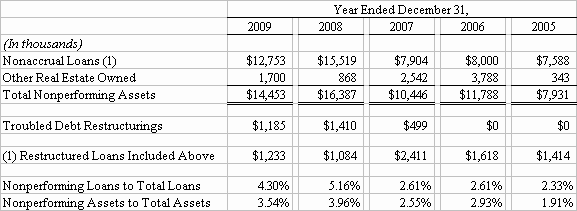
Other real estate owned, which is included in other assets, totaled $1,700,280, $867,507 and $2,541,615 at December 31, 2009, 2008 and 2007, respectively. The other real estate owned at December 31, 2009, consists of one construction and land development property valued at $1 million, one commercial property recorded at $150,599, three residential properties totaling $177,631, one ag-related property valued at $256,600 and two residential lots valued at $115,450. DBI acquired 14 properties during 2009 and sold 21 properties. The loss on the sale of the properties during 2009 along with write-offs on properties was $29,687. During 2009, DBI also incurred $471,601 of expenses associated with other real estate. These expenses consisted primarily of real estate taxes, repairs, insurance and legal.
The following table sets forth the maturities of various categories of loans (excluding loans held for sale) by primary collateral as of December 31, 2009:
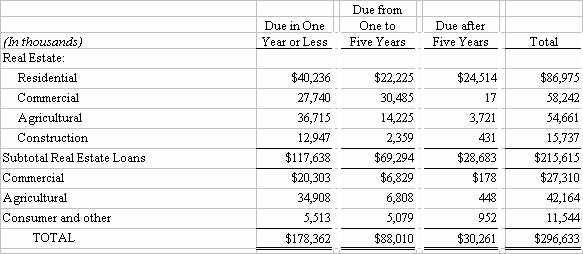
44
MANAGEMENT'S DISCUSSION AND ANALYSIS
See Note 13 - Related Party Transactions in the Notes to Consolidated Financial Statements for information concerning aggregate loans to related parties.

Allowance For Credit Losses
The allowance for credit losses is established through a provision for credit losses charged to expense. Loans are charged against the allowance for credit losses when management believes that the collection of the principal is unlikely. The allowance is an amount that management believes will be adequate to absorb losses inherent in existing loans and commitments to extend credit. The evaluations take into consideration a number of factors, including DSB's and DACC's loss experience in relation to outstanding loans and the existing level of the allowance for credit losses, changes in the nature and volume of the portfolio, overall portfolio quality, loan concentrations, specific problem loans, regular examinations and appraisals of loan portfolios conducted by state and federal supervisory agencies, and current and anticipated economic conditions. DBI applies risk factor percentages to certain categories of loans to estimate an appropriate allowance for loan and lease losses. Impaired loans are evaluated individually to determine an allowance related to those loans. The allowance for credit losses represents management's best judgment as to a prudent aggregate allowance in connection with the total loan portfolio.
At December 31, 2009, DBI's investment in impaired loans totaled $13,569,814 compared to $14,871,064 one year earlier. The impaired loans required a related allowance for credit losses of $833,461 at year-end 2009. Impaired loans are measured at the estimated fair value of the collateral.
In 2009 DBI's provision for credit losses was $5.5 million compared to $1 million and $903,000 during 2008 and 2007, respectively. Net charge-offs were $5,630,730 for the year ended December 31, 2009, compared to net charge-offs of $514,655 and $764,162 for the years ended 2008 and 2007, respectively. The ratio of allowance for credit losses to total loans was 2.10% at December 31, 2009, compared to 2.11% at December 31, 2008. The net decrease to the allowance for 2009 was $130,230.
DBI's ratio of loans more than 30 days past due (including nonaccrual loans) to total loans was 5.47% at December 31, 2009, compared to 5.87% and 4.02% at December 31, 2008 and 2007, respectively.
DBI's portfolio is heavily concentrated in DSB's four-county primary service area and would be subject to fluctuations in local economic conditions. DBI does have a concentration of agricultural-related loans amounting to approximately 33% of total loans as of December 31, 2009. The factors that influence the agricultural economy are complex and difficult to predict. Management's underwriting practices takes these cyclical price fluctuations into consideration. Agricultural loans more than 30 days past due (including nonaccrual loans) totaled $107,707 at December 31, 2009. This represents 0.04% of total loans outstanding and 0.7% of DBI's total past due loans. During 2009 there were $16,687 of net recoveries on loans considered agricultural-related compared to $19,167 of net recoveries during 2008. Management does not believe that these risks associated with DBI's loan portfolio have changed materially during the past three years.
Management believes its allowance for credit losses as of December 31, 2009, of $6,225,627, which equals 2.10% of total loans is appropriate to cover credit risks in the loan portfolio.
In 2009 DBI's ratio of charged-off loans to average loans outstanding was 1.98% compared to 0.34% and 0.29% during 2008 and 2007, respectively. During 2009, there were two large charge-offs for construction and land development loans. One was $1,424,175 on a relationship that was secured by a strip mall. This property was in other real estate owned that was held by DBI's real estate subsidiary as of year-end 2009. The other was $1 million on a relationship secured by a real estate development project. Charge-offs for loans secured by commercial real estate totaled $2,025,388 with $1,252,000 of that amount being attributed to two relationships. DBI charged-off $1,105,430 related to residential real estate mortgages. Charge-offs on loans secured by business assets were $233,575 during 2009.
45
MANAGEMENT'S DISCUSSION AND ANALYSIS
Changes in the allowance for credit losses in each of the five most recent years were as follows:
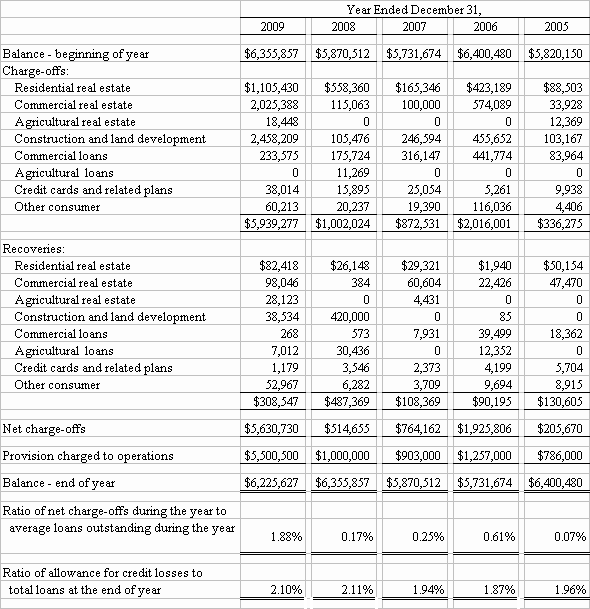
Deposits
At December 31, 2009, total deposits were $306,478,269, an increase of $476,822 or less than 1% compared to December 31, 2008. Certificates of deposit decreased by $3.1 million or 2% compared to the prior year-end. The average cost of funds for certificates was 2.92% compared to 4.05% one year earlier. Non-interest bearing deposits decreased by $2.8 million or 7% compared to year-end 2008. Money market accounts increased $3.3 million or 3% compared to year-end 2008. The average cost of funds for money market accounts was 1.09% during 2009 compared to 2.25% during 2008. NOW account balances were $2.7 million or 15% higher at year-end 2009 as compared to the prior year end. Savings accounts increased $461,658 or 3% over the prior year-end. The following table shows, as of December 31, 2009, the maturities of time certificates of deposit in amounts of $100,000 or more:

46
MANAGEMENT'S DISCUSSION AND ANALYSIS
The following table sets forth the deposits as of the end of each of the three most recent fiscal years and period-to-period percentage increases (decreases):
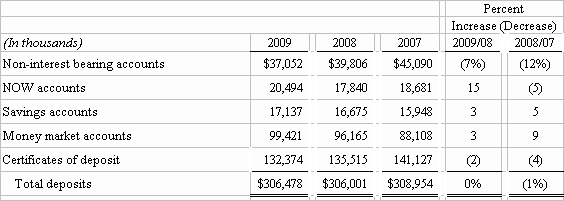
Investments
The investment portfolio is managed to provide liquidity and a stable source of income. Taxable securities are purchased and designated as available-for-sale to provide liquidity to meet loan growth or deposit withdrawals. Purchases of taxable securities are limited to maturities or average lives of ten years or less. Non-taxable securities are purchased and designated as held-to maturity. Generally these purchases are securities issued by state and local municipalities with maturities of 15 to 19 years and some protection against early calls (usually around 10 years). These purchases are made to take advantage of upward sloping yield curves that reward long-term investors with higher interest rates and favorable interest rate spreads when compared to U.S. Treasury and U.S. Agency securities. No securities are purchased for trading purposes.
As of December 31, 2008, all of DBI's holdings of corporate mortgage-backed-securities were rated AAA by Standard & Poor's and Moody's. During 2009, five securities were downgraded by the ratings agencies. As of March 31, 2009, three securities secured by non-traditional mortgage products had been downgraded. These securities were analyzed by a third party to determine whether they were other-than-temporarily impaired and if so, if any credit loss existed. Two of the three holdings were determined to have other-than-temporary impairment and credit losses of $312,716 that were recorded through the income statement in the first quarter. A fourth security was added to the evaluation process during the second quarter. It was determined that this security was not other-than-temporarily impaired. No additional credit losses were identified during the year. DBI will continue to closely monitor the performance of these securities. Note 3 - Investment Securities contains additional detail on the evaluation process.
The following table shows the maturities of investment securities at December 31, 2009, and the weighted average yields of such securities:

Yields on tax-exempt securities have been computed on a fully taxable equivalent basis, assuming a Federal income tax rate of 34%. Mortgage-backed securities are allocated according to their expected prepayments rather than their contractual maturities. Securities available-for-sale and securities held-to-maturity are combined in the table presented above.
Other Borrowed Funds and Contractual Obligations
At December 31, 2009, total borrowings decreased $4.4 million or 8% compared to the previous year-end. DBI utilizes a variety of short-term and long-term borrowings as a source of funds for DBI's lending and investment activities and for general business purposes. DBI has in place asset/liability and interest rate risk guidelines that determine in part whether borrowings will be short-term or long-term in nature. At December 31, 2009, DBI had $102.6 million of established lines of credit with $53.8 million in availability. Note 9 - Long-Term Debt of the Notes to Consolidated Financial Statements contains information concerning the significant terms of the long-term borrowings.
47
MANAGEMENT'S DISCUSSION AND ANALYSIS
During 2009, borrowings from the FHLB remained stable at $30.9 million. Federal Home Loan Bank (FHLB) advances and notes payable to banks consist of secured borrowings under existing lines of credit.
DACC's primary sources of funding are short-term and long-term notes payable to banks. As of December 31, 2009, DACC had established lines of credit of $30 million of which $17.0 million was drawn in the form of short-term notes payable and $4,250,000 in long-term notes payable.
DBI had an advance of $1 million outstanding as of year-end 2009 against its $6 million line of credit. This draw was done as of December 30, 2009 to fund the transfer of a foreclosed property valued at $1 million to DBI Properties, Inc. This was the only draw taken on this line of credit during 2009.
The following sets forth information concerning other borrowed funds for DBI during each of the last three years:
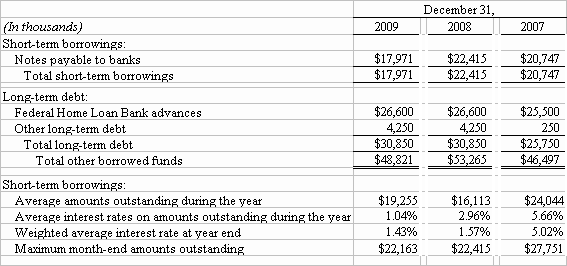
The following table provides information concerning DBI's known contractual obligations by payment date as of December 31, 2009:

(1) Includes interest expense based on outstanding interest rate.
(2) Includes all identified purchase commitments greater than $25,000.
Capital Resources
Stockholders' equity at December 31, 2009, decreased 2.2% to $51,103,648 or $431 per share, compared with $52,227,160 or $439 per share one year ago. Cash dividends declared in 2009 were $14.50 per share compared with $14.50 and $14.40 in 2008 and 2007, respectively. The dividend payout ratio (dividends declared as a percentage of net income) was 196%, 46% and 52% in 2009, 2008 and 2007, respectively.
Pursuant to regulations promulgated by the Federal Reserve Board, bank holding companies ("BHC's") with total assets above $500 million are required to maintain minimum levels of core capital as a percentage of total assets (leverage ratio) and total capital as a percentage of risk-based assets. Under these regulations, the most highly rated BHC's must meet a minimum leverage ratio of at least 3%, while lower rated BHC's must maintain a ratio of at least 4%. The regulations assign risk weightings to assets and off-balance sheet items and require a minimum risk-based capital ratio of 8%. At least half of the required 8% must consist of core capital. Core capital consists principally of shareholders' equity less intangibles, while qualifying total capital consists of core capital, certain debt instruments and a portion of the allowance for credit losses.
48
MANAGEMENT'S DISCUSSION AND ANALYSIS
The table set forth below describes the ratios of DBI as of the end of the three most recent years, and the applicable regulatory minimums.

The payment of future dividends by DBI is subject to the discretion of its Board of Directors and will depend on many factors, including DBI's operating results, financial condition and capital position. The ability of DBI to pay dividends on the Common Stock is largely dependent upon the ability of DSB to pay dividends on the stock held by DBI. DSB's ability to pay dividends is restricted by both state and federal laws and regulations. DSB is subject to policies and regulations issued by the FDIC and the Division of Banking of the Wisconsin Department of Financial Institutions ("the Division"), which, in part, establish minimum acceptable capital requirements for banks, thereby limiting the ability to pay dividends. In addition, Wisconsin law provides that state chartered banks may declare and pay dividends out of undivided profits but only after provisions have been made for all expenses, losses, required reserves, taxes and interest accrued or due from the bank. Payment of dividends in some circumstances may require the written consent of the Division. Note 17 - Regulatory Matters of the Notes To Consolidated Financial Statements contains information concerning capital ratios of DSB.
Management believes that 2010 earnings of DSB will be sufficient to pay dividends to DBI. DBI could also receive dividends from DACC, which has the earnings and capital strength to provide additional dividends to DBI. During 2009, DACC paid dividends of $1,462,500 to DBI. DACC had net income of $740,945, $831,597 and $610,808 for the years ended December 31, 2009, 2008 and 2007, respectively. The core capital as a percent of risk-based assets ratio of DACC as of December 31, 2009, was 27.7%.
Liquidity and Off-balance Sheet Arrangements
Liquidity refers to the ability of DBI to generate adequate amounts of cash to meet DBI's needs for cash. Loan requests typically present the greatest need for cash but liquidity must also be maintained to accommodate possible outflows in deposits. During 2009, net cash provided by operating activities which amounted to $2.2 million, the decline in federal funds sold of $5.7 million and the $2.4 million in proceeds from the sale of foreclosed assets, as shown in the Consolidated Statements of Cash Flows, provided the major sources of funding. The $5.5 million provision for loan losses, the $4.4 million net decrease in borrowings and the payment of $1.7 million in dividends were the major uses of cash during 2009.
DSB maintains liquid assets to meet its liquidity needs. These include cash and due from banks, marketable investment securities designated as available-for-sale and federal funds sold. DSB also has the ability to borrow approximately $18 million by means of the purchase of short-term federal funds from its principal correspondent banks. Management strives to maintain enough liquidity to satisfy customer credit needs, meet deposit withdrawal requests and any other expected needs for cash. Excess liquid assets are reallocated to achieve higher yields. One ratio used to measure the liquidity of banking institutions is the net loan to deposit ratio. The net loan to deposit ratio of DSB was 86%, 87% and 87% at December 31, 2009, 2008 and 2007, respectively. A high net loan to deposit ratio creates a greater challenge in managing adverse fluctuations in deposit balances and consequently this can limit growth. The net loan to deposit ratio reflects only on-balance sheet items. Off-balance sheet items such as commitments to extend credit and established borrowing lines of credit also affect the liquidity position.
In order to increase available funding sources DSB is a member of the Federal Home Loan Bank (FHLB) of Chicago. As of December 31, 2009, the amount owed to the FHLB was $26.6 million. The borrowings are secured by residential mortgages. The maximum amount of collateral that can be pledged to FHLB by DSB is limited by state law to four times capital. DSB could borrow an additional $20 million from the FHLB based on its $3.6 million investment in FHLB common stock and eligible collateral. DSB also sells loans to DACC and to the secondary mortgage market to improve its liquidity position. During 2009 DSB sold $26.1 million of residential loans to the secondary mortgage market. In 1999, a $20 million line of credit was established with the Federal Reserve Bank. To date, DSB has not borrowed against this line. Other sources of liquidity consist of established lines of credit by DACC and by the parent DBI. As of December 31, 2009, DACC has unused lines of credit of $8.8 million and the parent company has an available line of credit of $5 million. See Note 12 - Commitments and Credit Risk in the Notes To Consolidated Financial Statements for a discussion of DBI's commitments to extend credit. As of December 31, 2009, DBI has no off-balance sheet arrangements other than the commitments to extend credit and the standby letters of credit disclosed in Note 12. Management believes DBI's liquidity position as of December 31, 2009, is adequate under current economic conditions.
49
MANAGEMENT'S DISCUSSION AND ANALYSIS
Quantitative and Qualitative Disclosures About Market Risk
DBI's principal market risk exposure is interest rate risk. The objectives of DBI's interest rate risk management are to minimize the adverse effects of changing interest rates on the earnings of DBI while maintaining adequate liquidity and optimizing net interest margin. Interest rate risk is managed by maintaining an acceptable matching of DBI's asset and liability maturity and repricing periods, thus controlling and limiting the level of earnings volatility arising from rate movements. DBI does not hold any assets or liabilities for trading purposes.
DBI's interest rate risk is limited by the short-term nature of the loan portfolio and by the short maturity structure of time deposits. DBI's investment securities portfolio and long-term debt instruments contain more interest rate risk because of their long-term structure. During periods of an upward-sloping yield curve, management has purchased longer-term securities to take advantage of the higher yields. The held-to-maturity portion of the investment portfolio contains municipal securities with maturities as long as nineteen years and consequently is subject to greater market value volatility during periods of rising or falling interest rates. The excess of market value over cost mitigates the current risk of the held-to-maturity portfolio. The held-to-maturity portfolio represents only 7.8% of total assets at year-end.
DSB's Asset Liability Committee monitors rate sensitive assets and liabilities and develops appropriate strategies and pricing policies. The committee, which meets monthly, consists of at least three members of senior management. The committee operates under quantifiable financial guidelines measuring interest rate risk as approved by DSB's Board of Directors in the Asset Liability Funds Management Policy. The committee reports to the Board of Directors on a quarterly basis. The committee relies on, among other things, modeling simulations to project the potential effect of various rate scenarios on net interest income.
The tables shown below indicate the behavior of DBI's interest margin as rates move up and down using a technique known as rate shock. It simulates ramping rate changes over the next twelve months and the reinvestment of maturing cash flows and repricing of both earning assets and interest-bearing liabilities. In order to simulate activity, maturing balances are replaced with new balances at the new rate level and repricing balances are adjusted to the new rate shock level. The interest is recalculated for each level along with the new average yield. Net interest margin is then calculated and margin risk profile is developed.
The following table summarizes results of simulations as of the end of the two most recent years:


The computations of the forecasted effects of hypothetical interest rate changes on projected net interest income are based on numerous assumptions. The calculations assume a constant yield curve and do not take into account any loan prepayments in the event of a decline in interest rates. The computed forecasted effects should not be relied upon as indicative of actual future results. Further, the computations assume the Asset Liability Committee takes no action in response to changes in interest rates.
Management also measures DBI's exposure to interest rate risk by computing the estimated rate shocked economic value of equity. Under this technique the components of the balance sheet are marked-to-market to compute the market value of equity. It is similar to a liquidation value assuming all of the assets are sold at fair market value and all of the liabilities are paid off at fair market value. The market value volatility is a function of term. The longer the maturity term, the greater the volatility (risk). Balances with very short terms have little market value risk, while long-term balances, such as those contained in DSB's investment portfolio, have much greater market value risk.
Market value calculations are complex and require good cash flow information in order to be precise. The simulation model that DBI utilizes approximates the average life of earning assets and interest-bearing liabilities; therefore, the resulting market value
50
MANAGEMENT'S DISCUSSION AND ANALYSIS
computations are estimates. The average life calculations are then used as a proxy for duration. Duration is defined as the percent change in market value (price) of a financial instrument for every 100 basis point change in interest rates. Using this technique, the approximate market values for the major balance sheet categories are calculated for various rate changes. The market value of equity is equal to the market value of assets minus the market value of liabilities. The following table presents DBI's projected change in the market value of equity for various levels of interest rates as of the end of the two most recent years:
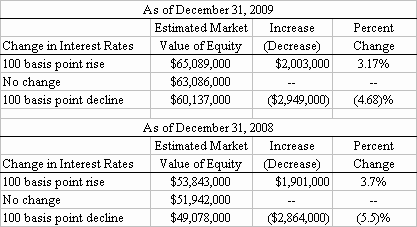
This analysis assesses the risk of loss in market rate sensitive instruments in the event of sudden and sustained changes in prevailing market interest rates. As of December 31, 2009, DBI's estimated changes in the market value of equity are within a range management considers acceptable. Certain shortcomings are inherent in the method of analysis presented in the computation of market value of equity. Actual results may differ from those projections presented should market conditions vary from assumptions used in these calculations.
The following table shows the repricing period for interest-earning assets and interest-bearing liabilities and the related gap based on contractual maturities, at December 31, 2009:
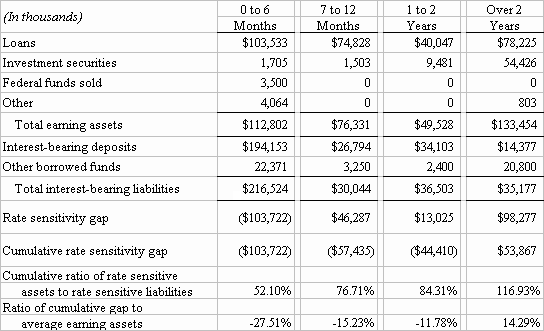
Mortgage backed securities are allocated according to their expected prepayments rather than their contractual maturities. For purposes of this analysis, NOW, savings and money market accounts are considered repriceable within six months. The above gap analysis is used to identify mismatches in the repricing of assets and liabilities within specified periods of time or interest sensitivity gaps. The rate sensitivity or repricing gap is equal to total interest-earning assets less total interest-bearing liabilities available for repricing during a given time interval. A positive gap exists when total interest-earning repricing assets exceed total interest-bearing repricing liabilities and a negative gap exists when total interest-bearing repricing liabilities exceed total interest-earning repricing assets.
51
EMPLOYEES OF DENMARK STATE BANK
|
Denmark Debra K. Ausloos Carol M. Behringer Christina M. Bienapfl Mary B. Buresh Sheena M. Craanen Terese M. Deprey Hilaria A. Dose Mary J. Doucha Lynnette E. Duckett Donna P. Emmer Jill S. Feiler Sara L. Fels Joanna B. Fischer Bonita M. Gauger Patricia A. Gremore Sara J. Halfmann Dennis J. Heim Tim L. Henke Melissa S. Hoyer Kevin W. Johnsrud Donna J. Kafka Melissa M. Kersten Betty A. Kittell Ellen M. Klarkowski Kim M. Kohn Linda L. Kolarik Ann M. Kozlovsky Lawrence J. Kozlovsky Evonne J. Kreft Carl T. Laveck Lynda A. Leanna Julie A. Lemmens Lonnie A. Loritz Stacy L. Magnuson Rachel J. Markvart Sandra R. Miller Shawn E. Mueller Kristina L. Nelsen Sarah L. Neuser Tamara A. O'Brien
|
Denmark John P. Olsen Tobias H. Olsen Anna M. Pearson Stephen N. Peplinski Tammy A. Pribyl Charles J. Rabitz Bonnie L. Reindl Linda M. Rentmeester Sarah J. Schley Diane M. Schlies Kenneth J. Schneider Steven M. Schneider Cynthia L. Shimon Lori A. Sisel Jeanne M. Swagel Kimberly J. Tess Deanna L. Tilot Jeffrey G. Vandenplas Allison J. Van Groll Leroy M. Verkuilen Cynthia M. Winiecki Jeanne L. Wolf Michelle R. Wotachek
Bellevue Brenda M. Allen Mary A. Bauer Molly J. Carriveau Joan M. DeGrand Jodi G. Havlovitz Amy R. Hertel Amanda J. Jacquart Ryan M. Johanek Chad R. Kofler Mary E. Kropp Patricia A. Olejniczak Katherine A. Pelnar Glenn J. Whipp
|
Maribel Edwin R. Duckart Debbie A. Grenier Linda M. Kuik Tami J. Pelischek
Reedsville Linda L. Beyer Barbara A. Lorrigan Joan C. Popp Sara J. Popp Darlene F. Schmieder Gail S. Wegner
Whitelaw Beverly J. Evenson Debra J. Habeck Deborah L. Kopidlansky David H. Radue Richard J. Schmieder Bonnie M. Vogel Kristine Weber
Wrightstown Tiffany L. Allen Polly L. Novitski Samantha M. Van Elzen Jeffrey J. Van Rens Katherine R. Wilson
|
52
DIRECTORS AND OFFICERS
|
Directors of Denmark Bancshares, Inc. |
Officers of DBI and DSB |
|
|
Janet L. Bonkowski Public Relations Manager Schneider National, Inc. Director of Denmark State Bank Terese M. Deprey Employee of Denmark State Bank Thomas N. Hartman President Hartman's Towne and Country Greenhouse, Inc. Director of Denmark State Bank Michael L. Heim President Heim Trucking Company Director of Denmark State Bank Kenneth A. Larsen, Sr. Sole Member, K.A. Larsen Consulting, LLC Director of Denmark State Bank Allen M. Peters Retired Teacher and Athletic Director Reedsville School District Diane L. Roundy Director of Business Development Schenck Business Solutions Director of Denmark State Bank Thomas F. Wall* Retired Sales Account Manager Natural Beauty Growers Director and Chairman of the Board Denmark State Bank Nominees for Director of Denmark Bancshares, Inc. William F. Noel Operations Manager St. Bernard & St. Philip Parishes Director of Denmark State Bank John P. Olsen* CEO and President of Denmark Bancshares, Inc. CEO of Denmark State Bank Director of Denmark State Bank |
John P. Olsen* CEO and President of Denmark Bancshares, Inc. CEO of Denmark State Bank Director of Denmark State Bank Jill S. Feiler* President of Denmark State Bank Vice President and Secretary of Denmark Bancshares, Inc. Carl T. Laveck* Executive Vice President of Denmark Bancshares, Inc. Executive Vice President and Chief Credit Officer of Denmark State Bank Dennis J. Heim* Vice President and CFO of Denmark Bancshares, Inc. Sr. Vice President and CFO of Denmark State Bank Lonnie A. Loritz* Vice President and Secretary Denmark State Bank David H. Radue Vice President Denmark State Bank Kimberly J. Tess* Assistant Vice President and Controller Denmark State Bank Jeffrey G. Vandenplas Vice President Denmark State Bank Jeffrey J. Van Rens Vice President Denmark State Bank Glenn J. Whipp Vice President Denmark State Bank
* Executive officer |
53
QUARTERLY FINANCIAL INFORMATION
MARKET INFORMATION
The following table shows market price information and cash dividends paid for DBI's common stock:
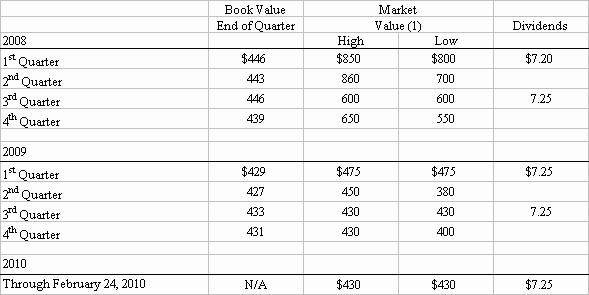
- See the following page for additional information about the market value of DBI Common Stock.
- The ability of DBI to pay dividends is subject to certain limitations. See "Capital Resources" in Management's Discussion and Analysis.
As of February 24, 2010 DBI had 1,610 shareholders of record. Beneficial owners of DBI's Common Stock whose shares are held in "nominee" or "street" name are not included in the number of shareholders of record.
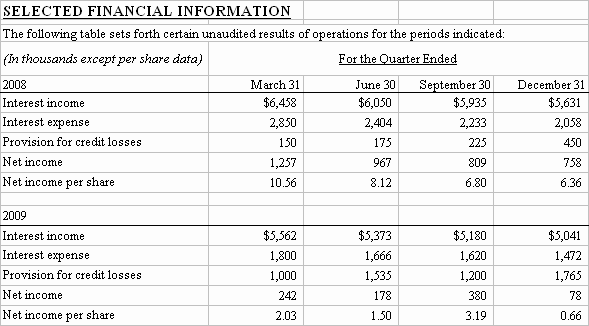
54
STOCK PERFORMANCE
STOCK PERFORMANCE GRAPH
The following line graph shows a comparison of the yearly percentage change in the cumulative total shareholder return on Denmark Bancshares, Inc. Common Stock with the cumulative total returns of the Nasdaq Bank Composite Index and the Nasdaq Composite Stock Market Index. Cumulative total shareholder return includes the change in year-end stock price and assumes reinvestment of dividends. The graph assumes $100 was invested in Denmark Bancshares, Inc. Common Stock and for each index on December 31, 2004. The Common Stock of DBI trades sparsely. There is no established market for the Common Stock of DBI and it is unlikely that such a market for the shares will develop in the foreseeable future. The prices of DBI Common Stock used to determine the cumulative total shareholder return for the years ended 2007 through 2009 are based on information obtained from buyers or sellers, may not reflect all transactions and may not be entirely reliable. The prices of DBI Common Stock used to determine the cumulative total shareholder return for the years ended 2005 and 2006 were based on repurchases of Common Stock by DBI pursuant to DBI's Stock Repurchase Policy. The Stock Repurchase Policy provided that shares offered to DBI could be purchased as an accommodation to shareholders at a specified percentage of book value computed as of the most recently publicly filed Form 10-Q or 10-K
preceding the purchase. The applicable percentage was 210% of book value from March 28, 2001 through September 11, 2006.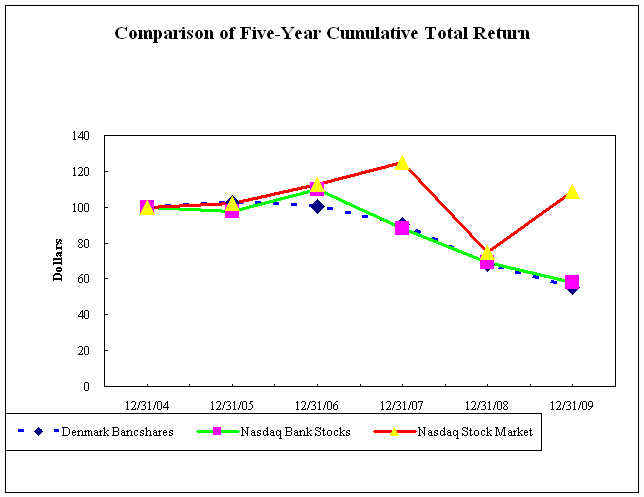

55
